#and travelling between my hometown and the city there are many people along the river
Explore tagged Tumblr posts
Note
What kind of things would Norway enjoy doing in the summer? maybe go fishing with a certain Scot…
I was just thinking about them going salmon-fishing together! ��� Brits have been visiting Norwegian rivers since the 1800s to fish salmon with Norwegians aiding them. I imagine Scotland and Norway still go fishing together in modern times - it's the perfect activity for them ✨

#hetalia#aph norway#hws norway#hws scotland#aph scotland#scotnor#thanks for the ask!! 🥰#I was thinking about salmon fishing because the season has started#and travelling between my hometown and the city there are many people along the river#ahh the sign of summer 🥰 salmonfishers
69 notes
·
View notes
Note
What is your favorite thing about Hokkaido?
Thank you for your ask! I’m a huge nature person, always have been. And what I love most about Hokkaido is that it isn’t as crowded as Honshu. I could ride my bike for 10 minutes and be surrounded by forest if I so desired.
Also, something that surprised me is that much of the flora and fauna aren’t all that different from that of Midwest America, which is where I’m from. So when I get really homesick, sometimes I just go for a bikeride along river and into the forests and just recenter myself.
Also, it’s just so beautiful here. Allow me to shamelessly share my terrible photography of various places in Hokkaido I’ve been to. (No filters on any pics)

What is Hokkaido without snow? (Asahikawa, Hokkaido, 2019)

Hatsumode is meant to be cold and snowy. (Asahikawa, Hokkaido, 2018)
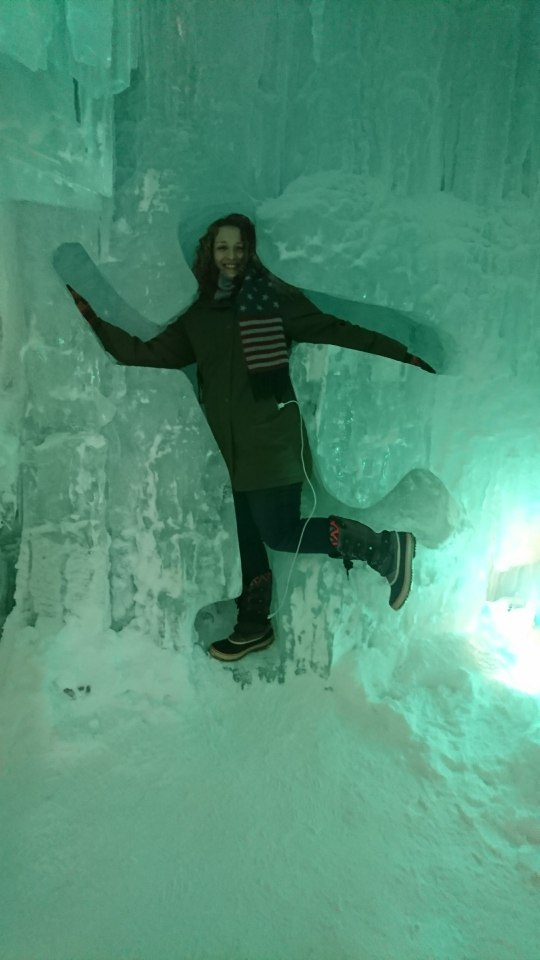
You just become one with the winter at a certain point. (Hyobaku Matsuri, Sounkyo, Hokkaido, 2018?)

But summer is beautiful too. Mild. These country roads with dilapidated sheds make me think of my hometown. (Somewhere near Kitami, Hokkaido, 2018)

Hokkaido is where I can see my favorite color of green in the summer. Biei or Furano, Hokkaido, 2014)

Ah, the Blue Lake (Ao Ike), colored this incredible shade of blue due to naturally occurring minerals. One of my favorite places to go. The blue is truly mesmerizing.
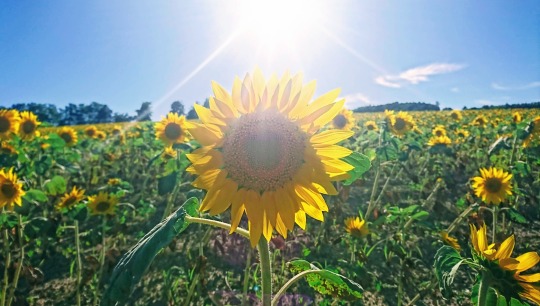
And the flowers! So very beautiful. My dad ran a flower business, but due to extreme motion sickness could never go on vacations with us. From the age of 6, I vowed to take pictures of all the flowers I saw for him, and I still do that to this day. (Sunflower fields at Hokuryuu, Hokkaido, 2018)
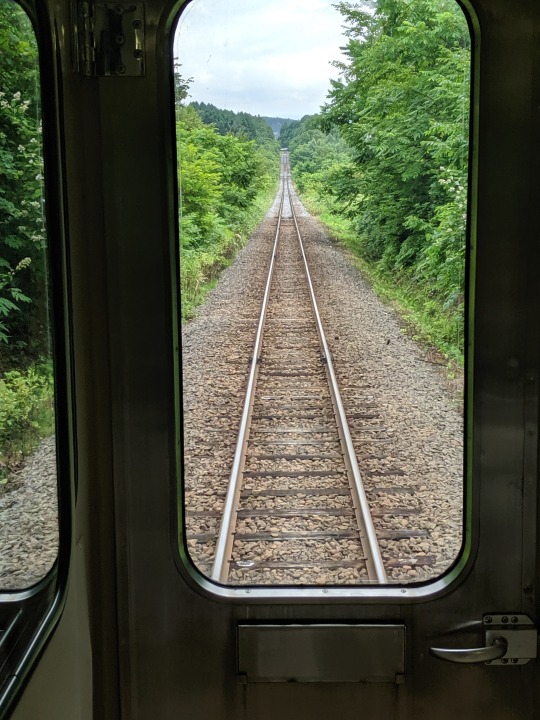
Sometimes if you are lucky, you can travel on one-man trains that are just one little car and you can stand right beside the conductor (out of frame to my left) and capture some beautiful scenery. (Somewhere between Furano and Asahikawa, 2019)

Ah, and who can forget the beauty of the fall leaves? I took a little trip to a small town called Kembuchi, which has a lovely lake surrounded by forest. There I stumbled upon this curious young fox who got so close to me I could NEARLY pet him. I have a strange affinity to them and tend to see them most everywhere I go, even in the city I live in. This is why I always bow and give a prayer of thanks to Inari-sama when I pass one of His shrines.

And let’s not forget the ocean scenery. This is Shakotan, a cape that is known for its waters’ unique blue color, as well as the fact that women were not allowed to enter the cape for centuries due to the danger. Now there is a nice walking path and anyone can travel to the very tip, which looks like this:

Sure do wish I was a better photographer haha.
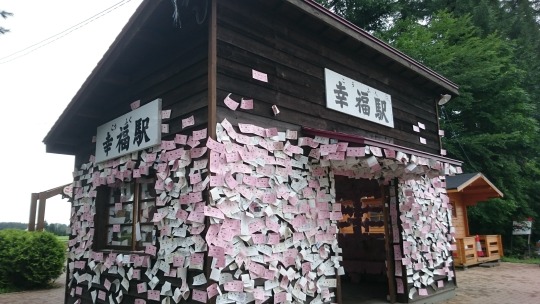
There are lots of little interesting towns hidden in Hokkaido. One such is called “Koufuku,” which means “Good fortune.” This used to be the train station for it, but the trains stopped running here decades ago. Still, many people travel to it, buy commemorative tickets, write their wishes on them, and stick them to the station. The inside is absolutely covered with them as well. Only 30 minutes away from Koufuku is Aikoku 愛国, the country of love. Many people buy tickets that say “from Aikoku to Koufuku” as souvenirs.

As I established, Hokkaido is cold. It is common practice to garb jizo statues with scarves and hats to keep them warm in winter, and I think this is just the most wholesome thing ever.
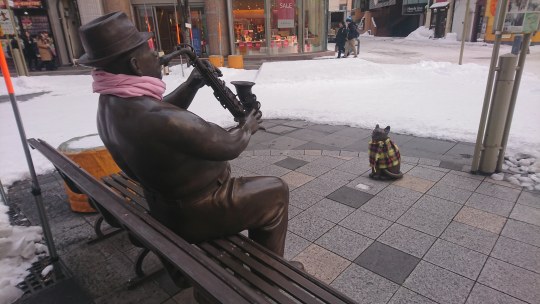
This practice can be extended to other statues as well haha.
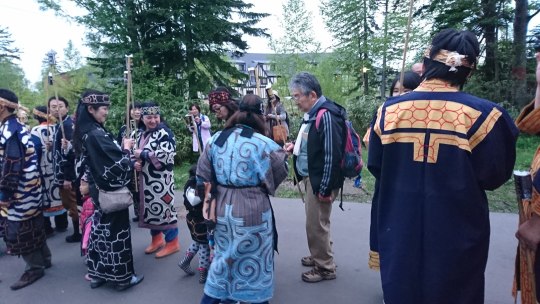
Lastly, something I especially love about Hokkaido is the Ainu people. They are an indigenous people of Japan who speak and entirely different language from Japanese and are thought have descended from the area of Russia many, many centuries ago. The embroidered patterns on their traditional garments distinguish which region they are from. Absolutely fascinating. I’d love to do an entire post on them at some point, but I frankly do not know enough and feel that I couldn’t do the people and the subject justice.
The Ainu were subject to much prejudice, and even to this day it lingers in subtle ways. My host mom told me that when she was a girl (60 years ago), Ainu people changed their names and did everything they could to hide their heritage, because they could not marry Japanese people and could not find many jobs if they were found out to be non-Japanese.
Now the Ainu people can show their pride for their culture and heritage, and there are festivals in which they carry out traditional celebrations. However, it is a shadow of what it once was. Here is a video of some traditional Ainu songs and dances.
youtube
And oh man, don’t even get me STARTED on how good the food is here.
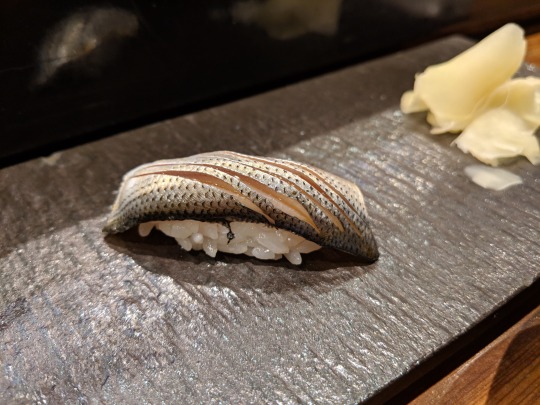
BEST SUSHI EVER.
#ask me anything#asks are open#hokkaido#japan#travel#travel japan#hokkaido is honestly the best place in all of japan and you can't convince me otherwise#only slightly biased#ikukokoko
624 notes
·
View notes
Text
Xiao Zhan – Beijing Beijing
Translator’s Note: This article comes from PEOPLE Magazine 2020 2nd Issue.
In between “seems beautiful” and “very beautiful”, there can be one or many different views. For example, the phrase “famous after a battle” (TN: Xiao Zhan’s “Zhan” sounds like battle in Chinese), we could analyze the keywords in many ways.
Xiao Zhan, born 1991. Could you imagine how you and I would be when we were 28? Xiao Zhan is like this –

Fan View
“His looks are totally my type” “As warm and gentle as jade, a gentleman who is peerless” “A precious boy with the soul as crystalline as prismatic glass”
“Famous after a battle”, is the most effective “wartime story”. Using this analogy in the entertainment business, there are many who had been battling for quite a while. Xiao Zhan is like this as well…
Audience View
The summer of 2019, the antihero Wei Wuxian (portrayed by Xiao Zhan), came from “The Untamed” into the living rooms of countless viewers, and straight into their hearts;
Platform View
As the Beijing TV Spring Night Spokesperson, as a celebrity with more than 20 million fans on Weibo, as Tencent’s “Most Popular Artist of 2019” and “Drama Actor of the Year”, as iQiyi’s “Breakthrough Popularity Actor of the Year”…
When we change our point of view, will the world become more interesting?
With regards to his looks, Xiao Zhan said he is “ordinary”, and only scored himself a 6.
With regards to his age, Xiao Zhan said his mother’s method of urging him to start a family has went from straight-to-the-point to indirect and tactful.
With regards to “famous after one battle”, is it really as straightforward as standing out from the big data and being ahead of everyone else? Xiao Zhan, who is 1.83m, reduced his weight from 70kg to 58kg for his outstanding portrayal of Wei Wuxian – is this really the result of a day’s work? Does anyone remember the hardworking youth, with a caption “Designer from Chongqing”, from the 2015 idol search variety show “X-Fire”? Does anyone remember that in 2016, after debuting as the lead singer for X9, Xiao Zhan admitted that there were instances of zero income, zero entertainment and zero social activities?
No matter whether it was “very beautiful” or it “seemed beautiful”, would it be free of worries?
Xiao Zhan looked down and smiled, slightly bashful, his expression serene, “Sweet worries.”

He actually loves Beijing so much
On 28 Feb 2019, I (a reporter) entered a dressing room in Beijing TV. The narrow and long dressing room had been split in the middle into two narrower sections. Near the corner, after the staff has dispersed, I finally set my eyes on Xiao Zhan, who sat obediently on a chair while styling his hair.
The stylist stood on the right of Xiao Zhan; to the left of Xiao Zhan was a giant suitcase. After we tried to push the suitcase aside, I managed to stand in the gap. In such a tight space, I could only put the phone in front of Xiao Zhan, on top of the opened makeup case, for voice recording. After some more effort from everyone, there was finally space for the phone.
He was covered in a white hairdresser cape, his long legs enveloped by a pair of black pants – his thick black hair was being kept in order, his handsome side profile, relaxed and natural attitude, polite words, and after some close observation, no piercings on his ears.
How did this unguarded Xiao Zhan look like?
There was no need for exquisite words, just simple and pure wonderfulness.
If it remained unimaginable, it would not be too complex to imagine the warm smiles of the good looking youths on the streets of Beijing. All of these people could have been born in Beijing or traveled to Beijing from their hometowns.
“Chongqinger” Xiao Zhan said, “Beijing, in fact, besides my hometown Chongqing, is my longest lived in city. If we use 2020 to calculate, it would have been 5 years. Beijing, is a striving city, and like any other youths, Beijing means dreams and endeavors to us – this is a city of ambition. Hence, as Beijing TV’s Spring Night spokesperson, I feel that this special meaning, I’m very happy and very excited.”
Indeed, during the release conference in the afternoon, when being asked about how he felt spending his “Year of the Rat” Spring Night with Beijing TV, and expressing that by singing, Xiao Zhan, who was nicknamed “The Little Chinese Music Archive”, thought about it seriously and suddenly sang, “I’m beautiful, beautiful, beautiful……”
Haha, this quick wit and humor was almost as cute as “The Chipmunks”.
Spring Night is a big event, and it required absolute secrecy. We secretly asked Xiao Zhan about Beijing TV Spring Night from his personal point of view. Xiao Zhan continued to be witty, “I feel it’ll be exciting, at least I’ll be performing with a… senior that I really like.” When asked who it would be, Xiao Zhan smiled, “Let’s keep it a mystery, and we welcome everyone to watch Beijing TV Spring Night!”
This “Chongqinger”, who still could not confirm if he could return to his hometown for Chinese New Year, would sometimes show his inner thoughts – “If I could go back I definitely would”, but yet his words lingered on Beijing TV Spring Night.
Xiao Zhan, he actually loves Beijing so much.

He actually likes Zhou Xun so much
Who are the actors that Xiao Zhan admires the most? If he were to pick two, it would be Zhou Xun and Tony Leung.
Xiao Zhan said, “I really like Zhou Xun, her views, her experiences, are all mesmerizing to me. She has many performances that give me the urge to rush into the screen to rescue her. Her performances are very vivacious, it feels like you’re beside her experiencing her performances with her, my attention is all on her, she just has great charisma.”
Xiao Zhan emphasized that he liked Zhou Xun all along, and as we stood and studied his side profile, his face, we suddenly remembered a classic scene from “Palace of Desire”, where the young Princess Taiping removed Xue Shao’s mask.
That year, Zhou Xun was 26, Winston Chao was 40, but it did not prevent her from portraying a young girl’s infatuation. This drama was almost 20 years old, and the female audiences at that time would exclaim that Winston Chao was “as warm and gentle as jade, a gentleman who is peerless”. If this seemed familiar, this phrase was also used by many of Xiao Zhan’s fans to describe him.
Time, in the long river of ages, cycles endlessly Memories, in our past and present lives, crosses endlessly
– Lyrics from “Yu Nian”
This is the lyrics from Xiao Zhan’s song “Yu Nian”, which is the ending song for “Joy of Life”. Who knew that time cycles? Who knew that memories crosses paths?
As of now, Xiao Zhan is similar in age to Zhou Xun’s age then. If we could time travel and Xiao Zhan were to act as Xue Shao, could we guess the ending?
And since we are at this point, we could add another statement – “Traffic” / “Celebrity” / “Actor” – what difference do they make in the face of time? If there are no answers, why not listen to Xiao Zhan’s “Yu Nian”.
Time will tell, it is just that we are too impatient – regardless of our need for speed, we still ought to seek the truth.

He actually admires Vincent van Gogh so much
Xiao Zhan, like many of us, went through the tough period of studying overnight for university entry examinations. He became a student of Chongqing Business and Technology University, majoring in Design. However, this did not prevent Xiao Zhan from becoming a “Top 10 Inter-school Singer”, he self mockingly called himself a “literary enthusiast”, but in fact became one of the stars in many girls’ eyes – someone who was good looking, tall, stylish and could sing and take photographs. Immediately after he graduated, he became a designer, but he would still be brought up by his ex-teachers, one of whom recommended him to participate in “X-Fire”.
When reviewing “X-Fire”, you would realize that Xiao Zhan had a round face, an obedient expression and mild temperament – in fact, you would think that he did not pose much of a threat. But as one by one, the youths started getting eliminated, as their teams were getting regrouped, as they were getting more and more difficult tasks, it seemed as though Xiao Zhan was being sculpted on the spot – his face became more chiselled, he started slimming down, his eyes started having the steady gaze of ambition… Talent search variety shows are, in fact, cruel and all the participants were getting re-sculpted and remodeled – whatever that was removed was not the meant to be in the final product.
So what did Xiao Zhan keep in his heart? These were all the passwords to his past – drawing, design and art. Like anyone who learnt design, they all had an artist that they favored, and they were all different. Xiao Zhan’s answer – Vincent van Gogh.
Xiao Zhan said, “I was asked previously – if I could have a conversation with a past personality, who would it be? I would just choose Vincent van Gogh, because I want to listen to what he had experienced then, how he lived then, such that he was able to create such a beautiful world and paintings. Such as “Starry Night” or “Self Portrait”, I feel that he was able to step away from himself, into very amazing angles, and then create them.”
Those who learned design would usually be able to draw quite well, and usually beyond the levels of self taught hobbyists. Hence, these would also become part of his self cultivation.
Xiao Zhan confirmed this, “Yes, I think starting from aesthetic views to detailed observation, I feel that there were definitely influences.”
On whether Xiao Zhan still went to art exhibitions, the question seemed like a luxury to him – his eyes widened, he straightened himself, and he started smiling widely, “There is very little time now for art exhibitions, I would see them via friends who went and posted in their social media, or those art-related media accounts.”
There could be no burden I could sway my head I could stay my steps I could surrender to you
– Lyrics from “Two Tigers”
This is the promotion song from movie “Two Tigers” sung by Xiao Zhan. There was once in a variety show that he was requested to use his facial muscles to move a cookie on the side of his face into his mouth, while singing. Before the game started, Xiao Zhan pointed at the camera and laughed, “I really do have an idol’s image burden! I really do have an idol’s image burden!” However, after the game started, you see no sign of his “burden”, just 100% into moving his facial muscles, working hard to get to the cookie.
What is an idol’s image burden? Is there art in an idol’s image burden? There are no answers, but we can look for it in Xiao Zhan’s “Two Tigers”.
Art often gave the answers to philosophy. For example, an idol’s image burden could be thrown away, hence it is definitely not art; Art follows the heartbeat, follows life, just like the Vincent van Gogh, a man whose life bloomed and withered like the summer flowers, in the hearts of people like Xiao Zhan.
This phrase “A designer who can’t sing isn’t a good actor” seemed nonsensical, but if you think about it, it seemed to suit Xiao Zhan a lot.

He actually yearns the audiences’ recognition so much
It seemed like Xiao Zhan did gain fame after a single battle, but it was not just one battle – there were more raging battles before then.
The dancing spirit, wearing bright red and green clothes, in “Monster Hunt 2” – the camera panned past him without a HD shot; The minor role of a special agent in “The Rookies” – with some onscreen time less than a minute… And there were more, such as “Star Academy”, “Oh! My Emperor”, “Battle Through the Heaven”, “Shuttle Love Millennium”… Never heard of them? Eh, well this proved a problem – how could there be so many people who became “famous after a battle”?
What next? Xiao Zhan happily shared, “If everything goes well, there would be three roles coming to meet everyone, two period, one modern.”
Alright, the modern role would be Doctor Gu of “Oath of Love”. In fact, there were already naughty fans yelling that they were going to register for Doctor Gu’s hospital. Two period roles from “Douluo Continent” and “The Wolf”. Which do Xiao Zhan like the most? Xiao Zhan was unable to answer, “I feel like I like them all. Three different roles, three different pace!”
So, for the audiences who are already familiar with the two roles from “Joy of Life” and “The Untamed”, which are the ones that are closest to Xiao Zhan himself?
Xiao Zhan shook his head, “They weren’t quite similar to me.”
With regards to his roles, his works, let us get to some quick Q&A.
Q: After experiencing the life of the role, would that some what affect yourself? A: I feel that there are some influences to my usual personality.
Q: Would it make you mature faster? A: I feel that it makes my life richer, it means that I have experienced multiple different lives.
Q: What is your long term goal as an actor? A: If we are talking about long term goal, it is definitely being able to act in a drama that I love, and then gain audiences’ recognition for that. I feel that this is my ultimate term goal.
Q: Which role do you like? How do you live with your roles? A: I feel that there isn’t the most loved, I’m just someone who enjoys the moment. For example, when I’m in the current role, I will invest myself entirely into that role, and then I will cherish him and love him. But when I have to go to my next battle, I will put him down and let him go. And then, I will invest all of my passion for the next one.

He actually likes to smile so much
Observing Xiao Zhan up close and personal – his head narrow, his face small and firm, the folded long legs were especially straight and long. Xiao Zhan, is really thin.
When asked if he was at his thinnest, Xiao Zhan smiled, “No, I was the lightest during ‘The Untamed’, it was shot with ‘Joy of Life’, that was the period. I feel like I’ve regained more than what I’ve lost.”
Wei Wuxian in “The Untamed” liked to smile, all the time, everywhere; Yan Bingyun in “Joy of Life” was cold, all the time, as cold as ice. These two roles shot at the same time, just the emotions were already poles apart – the effort in switching in between them definitely exhausted a lot of brain cells.
When asked if he remembered his longest working day ever since his debut, Xiao Zhan looked down and smiled, then exclaimed at the same time with me, “A few days!”
Whether he could mentally sustain the current pace was not the main point – whether he could physically sustain was hotly debated. On this, Xiao Zhan replied especially fast, “I could adjust to it, really! I personally preferred a busier schedule, the feeling of being busy, makes me feel more fulfilling, and more sense of security.”
“Sense of security” – Xiao Zhan used this phrase, how did he understand it?
For example, Xiao Zhan said that there were instances of him in bad temper, and then he was asked if he would flip tables. Xiao Zhan was slightly taken aback, and answered with a smile, “I can see that you’ve never done design, a designer is a contractor working for his clients, if the clients have opinions, you need to communicate properly and slowly convince them…”
Everyone has a different understanding and adaptation when it comes to “bad temper”, a lot of it came from experience and self control of emotions – similarly, our understanding and adaptation of “sense of security” would be different as well, because everyone’s sense of responsibility and experiences would be different. For a youth to openly bring up “sense of security” and fight for that, we could only choose to give him our blessings. Because, in the blur of the mind, we could almost see ourselves in him.
Before I could give him my well wishes, Xiao Zhan gave the readers and audiences an especially down-to-earth and warm blessing, “I feel that more well wishes are repeated too often. I will simply wish everyone a smooth path ahead, and then peace and safety would be nice!”
Finally, we would emphasize one point – Xiao Zhan really likes to smile!
Moreover, Xiao Zhan’s smiles are varied – there is gentle, healing, mischievous, surprising, confident, hearty, shy, embarrassed… and every one of these smiles could be extended into a language of its own.
There is this saying about a child who likes to smile…
His luck will never be lacking.
58 notes
·
View notes
Text
A Very Creole Christmas
Joyeux Noel, Y’all.
After thinking about doing a Hazbin History segment over the holidays, I finally decided to jump on in. As New Year’s approaches and many around the world celebrate Christmas, I thought it would be fun to write on holiday traditions unique to the American South and some customs specific to Louisiana. Nothing says winter holidays quite like garlands of native pine and... magnolias? Stockings full of... oranges? The taste of ... oysters? I grew up in Memphis and my family has deep roots throughout the South so a lot of these customs I have personally experienced.
This post is also not super planned out or edited. It’s a lightly researched thought dump. This is also not an exhaustive list. If I left something out, it is not intentional.
Holiday Customs of the Southern United States:
Citrus:
Tropical fruit may not be the first thing that comes to mind when you imagine Christmas time in America. But in the South, it is a very old custom dating back to the earliest days of coastal colonial communities. In colonial times, fresh citrus was an extremely rare and expensive delicacy. In early winter, ships loaded with citrus and other delicacies from Florida and the West Indies would begin arriving in port cities along the Southern coast. Nothing showed off New World wealth and connections in the colonial South like displays of fresh fruits and garlands of dried citrus. Fresh fruit became the ultimate luxury gift. The prickly pineapple in particular has legendary status in the city of Charleston and is sometimes associated with Southern hospitality. Placing oranges in stockings or giving gifts of gourmet fruit remain popular in many parts of the South today. Growing up, I often received at least one orange in my stocking for good luck and no scent says ‘holidays’ to me quite like the mix of orange and warm cinnamon. As an adult, I receive gourmet fruits at least once during the winter holiday season. Dried citrus is also popular in holiday potpourri and can still be seen in some contemporary holiday garlands.
Pecans:
This delicious nut grows prolifically throughout the South. Pecans are harvested between September and December and pecan based treats are a staple of any fall or winter gathering. The exact origins of many pecan based treats remain a mystery but folklore suggests that French settlers in Louisiana first created the iconic pecan pie as well as pralines. Bowls of candied pecans are a common sight at holiday parties or winter get togethers and they have a habit of turning up in winter salads too.
Magnolias:
A very fragrant, native plant synonymous with the South. It is also an evergreen. The use of pine for swags, wreath, and general decor has spread throughout the United States but the use of Magnolia in holiday decor remains mostly a Southern tradition. I was in Charleston and Savanna in December 2019 and saw a lot of Magnolia wreaths on houses. I don’t remember seeing it as much in my hometown of Memphis. It seems to be more common in coastal cities. The practice could also be on the decline due to the standardization of greenery sold at big box chain stores.
Oysters:
Oysters are both extremely popular and extremely plentiful in the south. They are a staple of coastal cuisine and are popular on special occasions further inland. Oysters are a pretty common sight at holiday parties. Almost every holiday party I remember growing up featured raw oysters on the half shell during cocktails. It also frequently appears in various holiday stews and even in holiday stuffing. Some people are ardent believers in the superiority of oyster stuffing at Thanksgiving and Christmas. I think I have to agree on this one. Oyster stuffing is delicious.
Rèveillon: A New Orleans tradition
Louisiana is unique in that it has French Catholic colonial roots, not Anglo-Protestant colonial roots. Much of early Louisiana celebrated Christmas as a predominantly religious holiday, reserving much of their more secular festivities for New Years. Over time, many New Years festivities would migrate to Christmas. One notable custom to come out of New Orleans was the practice of Rèveillon which was a late night feast to wake up the senses after the traditional Midnight Mass. Observant Catholics would attend holiday services on Christmas Eve and then indulge in decadent late night get togethers that lasted until dawn. French Creoles at the time were known for late night entertaining on special occasions. These meals could get unbelievably extravagant and naturally depended on quite a number servants, often slaves, to pull off. Servants and/or slaves would prepare the meal while the family was at church and clean up after the festivities were over. The practice gradually died because of the labor required, the incursion of ‘American” holiday culture, and a gradual shift towards a party culture focused on cocktails and nibbles instead of lavish multi-course meals. By the early 20th century only the most traditional families were still holding Rèveillon dinners and the practice went dormant for many decades in 20th century. Today, a modern updated form of Rèveillon is making a comeback in the New Orleans restaurant scene. To increase holiday dining and tourism, some New Orleans restaurants are now offering multi-course celebratory dinners in the spirit of Rèveillon. French speaking Creoles of the past would likely find at least some familiarity in the menus of restaurant Rèveillon feasts.
Bonfires on the Mississippi:
The mighty Mississippi dominates life and culture in the Delta from New Orleans to Memphis. In parts of the lower Mississippi, giant earthen levees attempt to contain one of the world’s largest rivers. Along these levees between New Orleans and Baton Rouge, a curious tradition emerged. Every year on Christmas Eve, the levees burst into flames as locals in St. Johns and St. James parish forgo electric twinkle lights for colossal burning pyres. I have not seen the Christmas bonfires myself but boy oh boy is it on my bucket list. It’s not exactly clear how this annual tradition started. Bonfires were part of ancient Celtic customs long before the arrival of Christianity and the tradition of celebratory fires was still a widely practiced custom when settlers began arriving in the New World. Perhaps settlers from Alsace brought the tradition to Louisiana. It is also possible that French missionaries started the custom of lighting bonfires. Another origin I have heard is that the fires were meant to help travelers navigate winter-time fog on their way to Christmas mass. However it started, it is now an integral part of Christmas festivities along the lower Mississippi. Previously people just gathered scrap wood. Now people build elaborate scrap wood sculptures in the shape of boats, plantation homes, pick up trucks, etc to light ablaze on Christmas Eve. The festival exploded in popularity after WW2 when subdivisions began reaching into these formerly rural areas, bringing in an influx of young families.
Well, that’s all I’m gonna write about tonight. Anything more and this will start looking like the beginnings of a hearty essay. Hope everyone is having a great holiday!
#hazbin histories#hazbin hotel#helluva boss#hazbin theory#hazbin alastor#hazbin fandom#alastor#radio demon
36 notes
·
View notes
Text
Transitional Territories
In the Philippine archipelago, crisis and opportunity constantly present themselves in equal measure. With 36,000 km of coastlines, it is one of the longest in the world. How uncanny it is that there are but less than ten local coastal engineers and planners who are expertly qualified in managing these. It is an entire country riddled with delta communities and cities whose growth have become unprecedented and vulnerabilities more exposed in recent years, nobody knows who truly takes care of them. Who are the guardians of the coasts? They are the indigenous tribes who have protected and lived by the coasts in prehistory remain yet are still shunned by the government from their own development plans and responsibilities. These refluent and steadfast people are the most connected with our pre-colonial history, our true roots, are those treated as outcasts and whose own ways of living should serve not as warnings yet of teachings of vulnerability and of heritage and identity, and thus pride.
I have traveled much away from the city in the last decade of my life, engaging with different indigenous and local communities and having had the opportunity to involve myself in masterplan projects of coastal municipalities like Butuan City, Agusan del Norte and Atimonan, Quezon, notwithstanding also working on my mother’s sinking coastal hometown of Hagonoy, Bulacan for my undergraduate thesis. These experiences have awakened in me how water must be a crucial aspect in determining the direction by which the studies and visions for such areas would be conducted and implemented in long-term plans, and yet I have observed how water is merely used as a technical risk factor instead of being seen and applied as the link to authentic development that also encompasses the social and political. I have thought to myself, “How many more municipalities and cities like these in the Philippines are more impacted and need better coastal planning and development? Or merely understanding? Could the quality of the relationship with water of the communities living therein be proportional to their growth and quality of life?” Water, I have come to believe, is a key element if not THE key element for understanding who we are and what we may yet become.
Coastal territories that span wetlands and marshlands both intrigue and fascinate me. They are the in-between zones in where indigenous cultures and traditions now overlap with contemporary sensibilities, where the land cleanses itself. The social layers of colonization, political upheavals, and both ecological and environmental disasters teem here no matter how remote they may seem from the urban life of mega-cities many people migrate to with another layer embedded; that of temporality of time. With the desire to further explore this and express my tenderness for water and the island nation I come from, my primary choice is the Transitional Territories studio. And with the Accumulation-Clearance theme that the studio is beginning with this year, I feel an utter connection with accumulated pasts, cultures, and practices that define the river settlements and coastal landscapes of the country that could direct what is yet to come or what can come for us; a clarity.
A different, more visionary process and approach is vital – one that would amplify the involvement of the most vulnerable sectors, enable local knowledge, and pave the way for an alternative model for water resilience to emerge. As an avid diver who once headed an organization that promoted the awareness and conservation of the marine environment, I feel deeply and have observed how water in all its forms– oceans, lakes, rivers, lagoons – and meanings are always tied to the people that live with them. A possible focus for this study would be communities in river settlements in the tropical region, which are the densest along coastal zones, and thus, are the most vulnerable as the river becomes the urban touchpoint with nature. In the Philippines, most of its economic activity and population growth resides therein. Identifying, strengthening, and protecting these areas must be placed at the forefront of development plans not only by local governments, but to be strategically mandated and implemented by the national government, albeit with fresh eyes.
Although, more than solutions, it is the way of thinking and seeing I am more excited and interested in uncovering through my graduation project that I believe TT can offer as “It approaches the state of risk and fragility in coastal, riverine, and/or deltaic landscapes as an opportunity to move away from existing paradigms and envision an urbanism of care.” The inclusion of ‘care’ into the program is something I value and wish to extend as I seek out and be guided by new approaches and standards that could enrich my own understanding and knowledge about water and its relationship with the built environment by delving into design by research methods in the more specific realm of delta urbanism. I aim to create a project that not only holds much meaning yet shall be expressed well; to create an inventory, an atlas, a new language, or whatever expression by which these multitudes and layers could be unwrapped, understood, and celebrated. 9 September 2022, The Hague, NL
0 notes
Link
It was 8pm on a scorching summer night when Tien, a quiet, timid teenager, left her home in a coastal province of central Vietnam, supposedly to spend the night at her cousin’s. Or at least, that is what the 16-year-old had told her family. In fact, she planned to leave the village to escape the pressure on her to get married. Hoping her cousin would help her find a job, she slipped out the door.
It was nearly two years before she would return, by then having endured horrors beyond the imagination of most teenagers. The cousin she had trusted, rather than finding her a job, had sold her to a human trafficking broker in China who resold her as a bride. Tien became part of a depressing new statistic: the growing number of impoverished Vietnamese children being sold into forced marriages in China.
Tien had realised early on that something was amiss. “I gave her all of my money and my ID card,” Tien recalls. “She told me, ‘we’re going to find work. You said you wanted to leave that village so I’m taking you’.”
Her cousin had promised to take her to the big cities in the south, but instead they headed north, to the capital Hanoi. They switched vehicles in the capital and Tien fell asleep. When she woke, she was in China, where her cousin abandoned her after selling her to a trafficking broker.
Tien soon learned the broker had already matched her with a husband. She put up a fight, refusing to leave the broker’s house for four months, but eventually gave in, having met a fellow Vietnamese who told her the only way to escape the country would be to learn Chinese – and that the best way to do so would be to marry. So she let her broker find her a new match.
Tien’s ordeal is far from unique. Disappearances like hers have become so frequent in some rural areas of Vietnam many villagers assume that if a girl has been missing for more than a couple of days she must already be on the other side of the border.
Official statistics from Vietnam’s Department of General Police show that between 2011 and 2017, there were 2,700 reported cases of human trafficking, involving nearly 6,000 victims mainly from poor families in rural areas, with little access to education or economic opportunities. The official figures are widely thought to be dwarfed by the number of unreported cases. Police say selling children as brides is rife in provinces near the border with China and is on the rise.
In China, where men outnumber women by 34 million – more than the entire population of Malaysia – websites offer foreign brides to fill the gap. The service comes at a price, usually somewhere around the 10,000 yuan (US$1,500) mark.
The stories of the women who end up becoming these brides are nuanced. Some are lured into China with false promises of jobs and better lives, but end up forced into marriage or even brothels to become sex slaves. Some are tricked by someone they trust – a relative, a friend, even sometimes a boyfriend who promises to marry them, but instead sells them. Some girls are drugged, then taken across the border.
Other girls are given up voluntarily by families who are made to believe they will receive a dowry (often “less than the price of a buffalo”, villagers would say, usually between US$600-US$2,200), but instead find their daughters have been kidnapped and sold on.
Once the women have been married off, various forces conspire to keep them in China. Some are effectively imprisoned by their new husbands, others are too afraid to return as the stigma they bear means they will be unable to marry again in Vietnam.
Ma Thi Mai, a Hmong woman in her 30s from Sa Pa, an impoverished rural town in northern Vietnam, was sold by her boyfriend. “After my first husband died, a man got my number from an acquaintance and tried to reach out to me,” she recalls.
They soon became infatuated with each other – or so she thought. Within just two weeks he had asked her to leave her home in the terraced hills of Lao Chai village to visit his family in Lao Cai, a border city separated from China by a confluence of two rivers. It is notorious as a crossing point for human traffickers.
As they crossed the river in the dead of night on a raft, Mai was unaware they were entering another country. She had never travelled that far from her hometown.
“I did not know it was China until I saw the signboards in different letters and the people were speaking in a different language,” Mai says. “He sold me to a Chinese woman, who then sold me to other men.”
Mai became a modern-day slave. She was sold and auctioned at least five times, and was kept constantly on the road. Angry men would threaten and beat her if she protested or even wept. “They sold me like an animal,” she says.
Dang Thi Thanh Thuy, a case manager at Hagar International in Vietnam, an NGO that provides help for women and children who have escaped sexual slavery and human trafficking, says victims suffer psychological traumas that can scar them for life.
“The initial responses of women who have been rescued can be either panic or disassociation, depending on their ways of coping with trauma,” she says. “If they are frightened or agitated, they might even try to commit suicide, break down or scream. But if they experience emotional numbness, they feel depressed and have no motivation to do anything.
“All of these reactions are rooted in their insecurity. They no longer feel safe and protected.”
Lao Cai is infamous for trafficking. Ethnic minorities and children in Lao Cai are often the traffickers’ main targets, according to a report by Unicef in 2016.
Domestic violence is common in Lao Cai, even though in many cases the women there are the main providers for their family. The area is popular with backpackers and many Hmong women make a living as trekking guides or by selling souvenirs. Those who can’t speak English and have nothing to sell often survive by working on farms. Others look north to escape the poor living conditions.
Mai married her first husband when she was 14. By the time she was sold into her second marriage – sometime in her mid-20s, she is not sure of exactly when – she had already had two children.
Since she returned home – she escaped China by flagging down a police car – she has received neither psychological nor physical support, despite having reached out to local authorities.
She now spends most of her time toiling in the fields to support her sons.
Meanwhile, the “boyfriend” who kidnapped her walks around freely, despite having been reported for the crime. She saw him recently at the local church, wearing her Hmong xauv necklace.
“His father works for the local government,” she says. “I’m sure if he could sell me, he must have sold other women too. He was very experienced and knew what to do.”
“I wish he was in prison, because what he did was like killing me. He sold me, he stole my stuff. It still hurts so much when you think about it.”
At a nearby village in Ta Van, clay houses with thatched roofs are clustered together in the mountains, overlooking beautiful vast swathes of green terraced fields in the sunny May weather.
There, in their nearly empty, unequipped houses, two mothers, Sung Thi Ku, 54, and Giang Thi Su, 40, count their days waiting for news of their missing daughters.
Both of Ku’s daughters are in China – though neither has ever told Ku what they are doing there. Ku believes they were both sold to traffickers after leaving for China voluntarily, and blames their husbands’ families. “My first daughter’s husband told her he did not want her any more. His family mistreated her, and she wanted to leave for China, so she did with her friend,” Ku says.
In the five years since her eldest daughter left, Ku has heard nothing from her. Ku’s younger daughter left home at 21, about two and a half years ago. Soon after the 2018 Vietnamese Lunar New Year, Ku received a call from a Chinese number. It was her younger daughter.
“She told me to work hard and stay healthy, she was staying in China and she had a family and a child already,” Ku said.
“She told me she cannot come back to Vietnam.”
The other mother, Su, is still in contact with the daughter she lost. One day, her daughter had come home with a group of Chinese people who asked Su for her daughter’s hand to marry. Su did not know they were human traffickers at the time, even though things did not feel right.
“They kept touching my daughter’s hair, body, hands,” she recalls.
“They told us to trust them, that we could come with them to China for one or two days if we wanted.”
Su warned her daughter not to go with the people, but her daughter left anyway, accompanying the group with a friend and the friend’s father. They stayed at an inn near the border, and when the friend’s father woke up the next day the Chinese group had vanished along with the girls and without paying the dowry. The girls were just 17 years old.
Su’s daughter, now 20, was married to a man whose first wife had died. He does not allow her to return to Vietnam because he fears she would run away. She is not even allowed to call.
“I was angry and I cried a lot,” Su says, breaking into tears. “I thought those people did some magic to my daughter, that is why she did not listen to me any more.”
Out of the six thousand victims identified by Vietnam’s Department of General Police, only around 600 have returned to Vietnam.
Among them is Cau, a Hmong student who was kidnapped by the aunt of one of her friends and taken to China when she was 17. The aunt then sold both Cau and her own niece to traffickers.
The traffickers took Cau across the country, to Zhejiang where Cau met many young Vietnamese women, from Son La, Lai Chau, and even her own hometown Mu Cang Chai, who were eager to meet her.
“I met a 14-year-old girl who had been kidnapped and was married to a 36-year-old man,” Cau recalls. “I asked her how she knew I was in town, she said her Chinese husband had told her there was a Vietnamese girl who had just arrived. She also came from Mu Cang Chai, and she told me she missed her hometown, so she wanted to see me and talk to me.”
After three months, Cau managed to escape the house where she was being kept and ran to the nearest police station. Her description helped the police to locate the house where she had been held.
The Chinese traffickers were arrested, but the Vietnamese ones had already escaped. Her friend is still missing.
Vietnam lacks a comprehensive repatriation mechanism to reintegrate human trafficking victims into ordinary life. Women who voluntarily went to China – even those lured under false pretences like the daughters of Ku and Su – are considered “off record” and do not qualify for any of the state initiatives offering financial or psychological support. The same is true of those women who, like Mai, escape their traffickers and return to Vietnam under their own steam.
Yet these women are in some ways the most vulnerable. Their wounds never completely heal because of the social stigma and discrimination they may experience. “In our society, there is still a common response towards human trafficking: victim-blaming,” says Thuy, the case manager at Hagar. “Many people still label the victims as ‘bad girls who deserve to be trafficked’, or ‘lazy, greedy people who want to earn money easily’.
“Such reactions exacerbate their past traumas, and can easily traumatise them again. They come to perceive themselves the way the society does, and start blaming themselves.”
Back in Hanoi, Tien, now 21, has gone back to school and is starting a new life. When she first returned to the country, neighbours made her feel unwelcome.
“When I got back, I felt like there was a wall in front of me, especially when I talked to other people,” Tien says. “I was very afraid. I didn’t want to talk. Many people would make jokes out of my pain and thought it was funny.”
Her past came back to haunt her. The family in China she had escaped from recently contacted her to try to persuade her to return. She changed her sim card, fearing they might one day track her down.
Now she doesn’t tell people she meets about her past; none of her schoolmates are aware of what happened to her. She has regained her self-confidence, something she attributes to being encouraged to continue her studies by the staff at Hagar.
“It feels like a dream I’ve had for so long,” Tien says. “I’ve learned to forget about my past and feel more integrated into society.”
Tien’s ambition now is to become a social worker, just like the ones who brought her back to life.
40 notes
·
View notes
Text
Mountain Altai, country of the spirits.
Greetings, my dear reader! Today I would like to tell you on my blog page about the region of the country that is popular in Russia and is loved by all Siberians — the Mountain Altai. Perhaps in this difficult time for the whole world, we need reasons to distract from sad thoughts, to dream about future trips, when the Covid-19 epidemic will finally be defeated by humanity and all roads and borders will be opened to us again.
So, this is a post about natural and tourist attractions. A kind and dreamy topic that I would like to write about in my blog first of all.
Everyone loves the Mountain Altai. Perhaps outside of Russia this area is not as well known as for example the same lake Baikal or other business cards of tourism in Russia. Or am I wrong, and this is a fairly well-known topic? My dear reader, feel free to write about it ;)
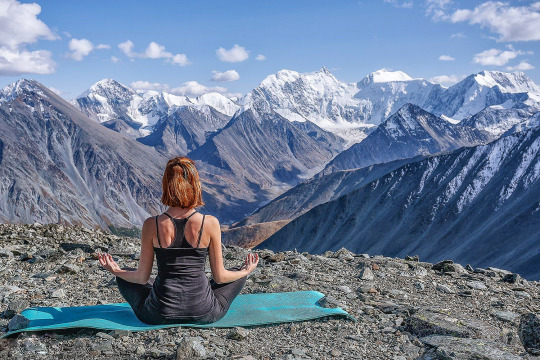
In any case, I hope you will be interested to learn something new. Or just look at photos of nature. This is a review post, it will not contain much specifics, if you want to find out more, write to me, and I will try to cover the topic that interests my reader in more detail.
Mountain Altai is an amazing and very beautiful region, about which many enthusiastic words have been said and written. Golden mountains-this is how Altai is translated from the Turkic languages. Mountain Altai is located in Central Asia, Siberia and borders countries such as China, Mongolia and Kazakhstan. The capital of the province is Gorno-Altaysk. The most popular place to start a trip to Mountain Altai, where there is a major transport hub and an international airport — the city of Barnaul.
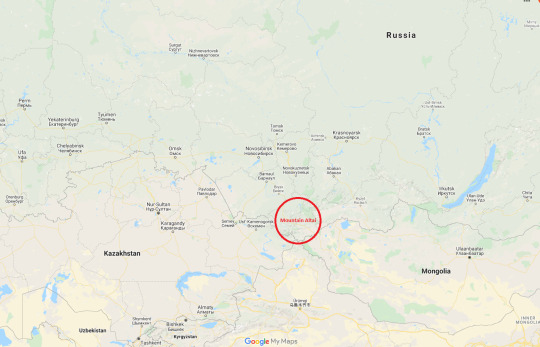

Residents of the European part of Russia sometimes confuse the Mountain Altai with the Altai country. These two regions border in the Siberian Federal district, but they are quite different: mountain landscapes are typical for the Mountain Altai, but the Altai country is green steppes and Terry hills.
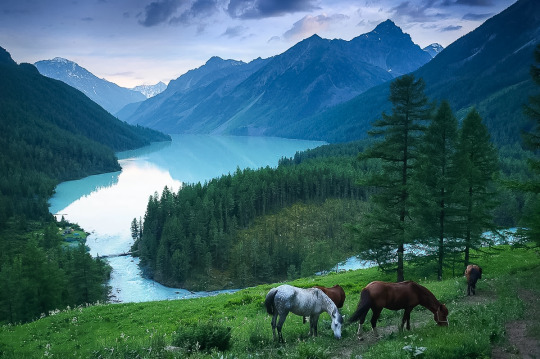
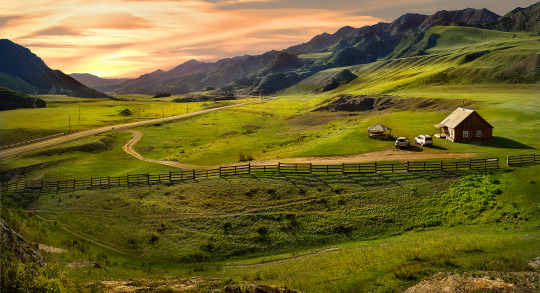
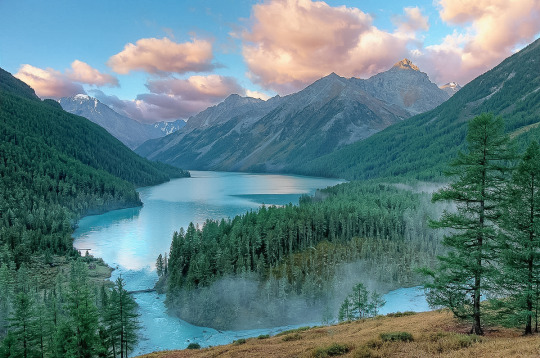

Mountain Altai is probably one of the favorite vacation spots of my countrymen.. About 700–800 kilometers from my hometown is just a day’s drive away. You can have time to go to the Altai for some long weekend. It should be noted that Mountain Altai is one of the cleanest regions of Russia. There are no industrial enterprises or Railways. Only infinitely beautiful and fascinating nature. It seems impossible to remain indifferent to the natural beauty of the Altai mountains.
The nature of Altai is not just diverse, it is extremely contrasting. Taiga forests quickly give way to dry steppes, low mountains and hills change to snow-capped peaks, among other things the highest in Siberia, and rivers and lakes here change their color depending on the time of year. The weather and climate in the neighboring valleys can vary greatly — Altai is striking for its variety of nature and landscapes on a relatively compact area of the planet, which is of course extremely convenient for tourists.

At the same time, the tourist infrastructure is relatively well developed (in the whole Eastern part of Russia). First of all, of course, tourists should count on an inexpensive and unpretentious level of tourist bases, especially far from civilization. But there are also more expensive hotels for the demanding traveler. I am glad that here you can arrange a vacation at any level of available funds, while the prices IMHO are the most honest and balanced in Siberia.
It is worth noting that the Altai mountains with their natural attractions are included in the UNESCO world heritage list.
This is the Land of seven thousand lakes, turbulent rivers and silent landscapes. Here rises the largest mountain in Siberia, and passes one of the most picturesque roads in the world, archaeologists find ancient artifacts in mounds, and shamans conduct their mysterious rituals in places of power.

In ancient times, the paths of nomadic tribes crossed in the Altai mountains. Hundreds of thousands of years ago, people already lived in this area, and traces of them are found throughout the territory: unique rock petroglyphs, burials in places of power, and Parking lots.
For centuries, this harsh but picturesque region was part of the great Mongol Empire: the horses of Genghis Khan’s army trampled the delicate bowls of Edelweiss in the valleys and overcame steep mountain passes.
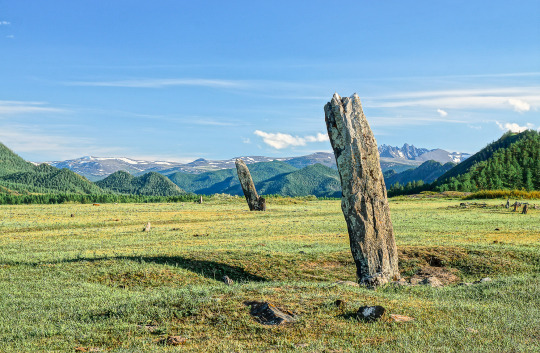
Altai is an ideal place for eco-tourism. The main value of the region is its nature, and the path to the most picturesque places is often thorny, but the effort is worth it. Here you can organize a week-long hike, swim in one of the crystal-clear lakes, go fishing or pick berries.
Another format of travel in the Altai is ethnographic excursions. For example, in the Yurt-gallery of Kalambina Zheltkovskaya, guests are introduced to traditional felt products, and in the ethnomaster “Aychus” they are told about Turkic patterns, learn to make amulet dolls and play national instruments: Komus and Topshuur.
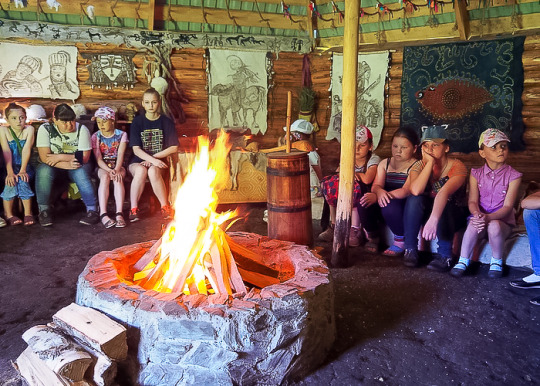

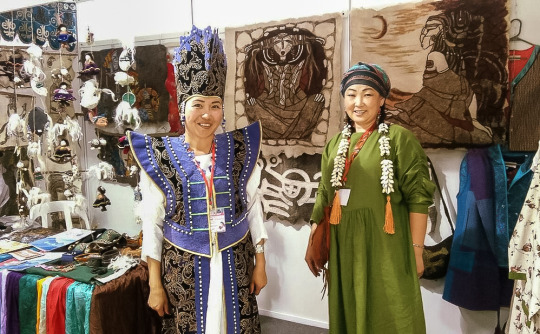
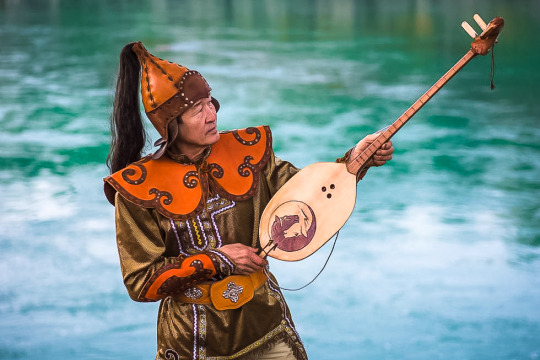
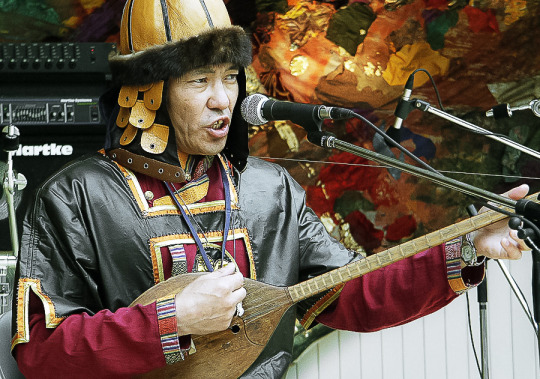
national musical instrument Komus:
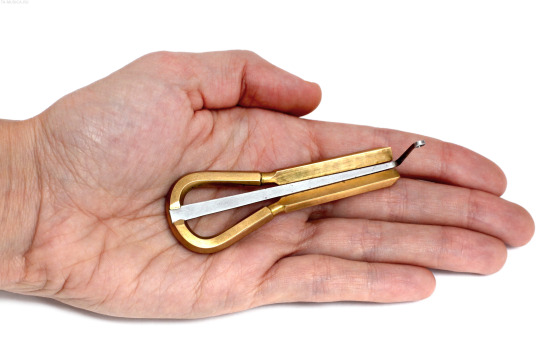
national handmade guardian amulet Aichus:
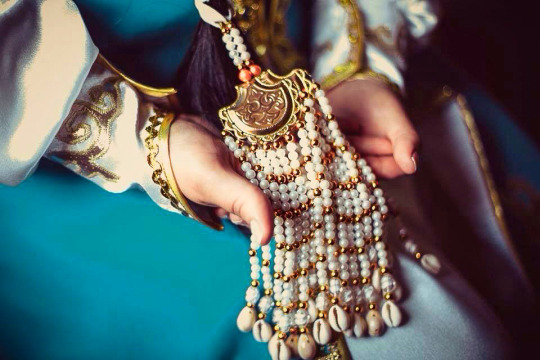
And, of course, extreme tourism! Ascents to the peaks, rafting of any level of complexity on rough rivers, skiing: there are good trails on the shore of lake Teletskoye, and the resort “Manzherok” is not only the slopes, but also the first professional Bike Park outside the Urals.
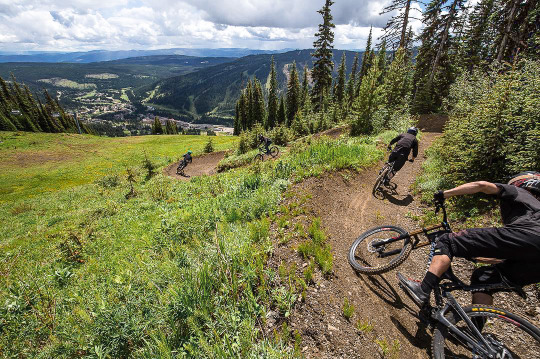

What to see in Altai? Cascades of rivers, mountain tops, crazy passes. What to do in Altai? Wake up with the sunrise, wash with cold water from the stream, admire the views from the car window, conquer the mountains, breathe deeply, listen to the legends about the eternal lands that the locals love to tell in the evenings.

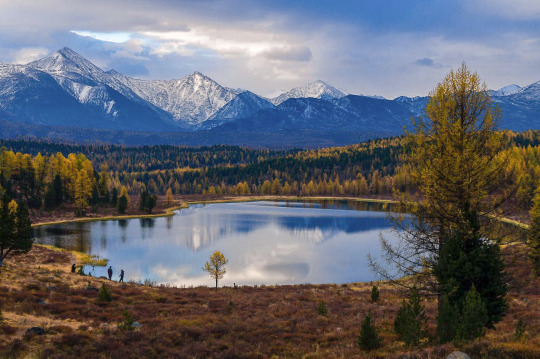
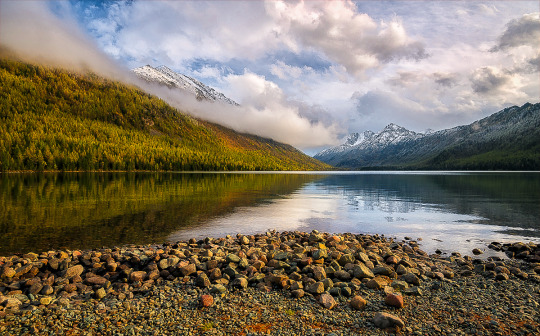
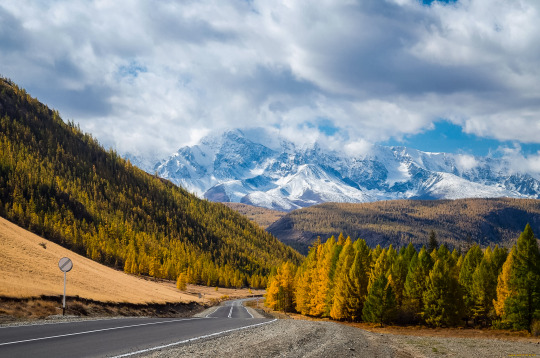
Who is suitable for a holiday in the Altai mountains?
This region is for those who are willing to sacrifice comfort in order to see the incredible landscapes and pristine nature with their own eyes. There is often no net, you can only drive an SUV, and from the nearest village to the next lake or mountain you need to walk for several days. But it is in such places that you relax from the city, put your thoughts in order and get charged with energy!
The best way to explore the Altai Mountains is to travel by car along the Chuysky tract. This is a Federal highway with a length of 968 kilometers that crosses the region from Novosibirsk to Mongolia, it is called the most picturesque road in Siberia, and the magazine National Geographic Russia even included the Chuysky tract in the top 10 most beautiful roads in the world!
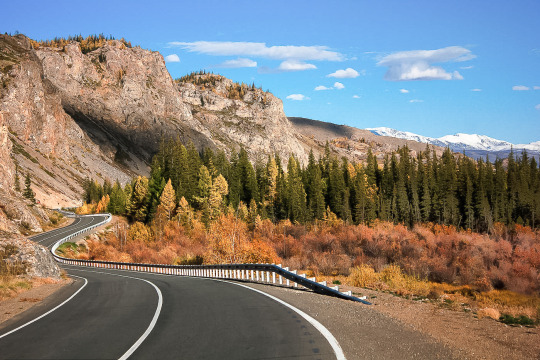
In places, the remains of the old road remain near the new highway. The Chuysky tract has existed for many centuries and in ancient times was part of the Great Silk Road from China to Europe!
ancient and modern photos of the preserved section of the old Chuysky tract:
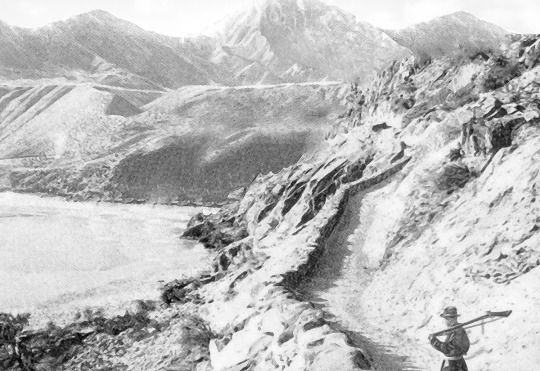

In the year of Gorny Altai is visited by about two million people! Today I’m talking about what is interesting in this region and where to look for the most-the most places.
The mountain Devil’s Finger
On the way from Biysk to the Seminsky pass, make a small stop and climb the Devil’s Finger. The ascent will not take much time, but you will get a stunning view — it is not for nothing that it is included in almost all the lists of “What to see in the Altai”.
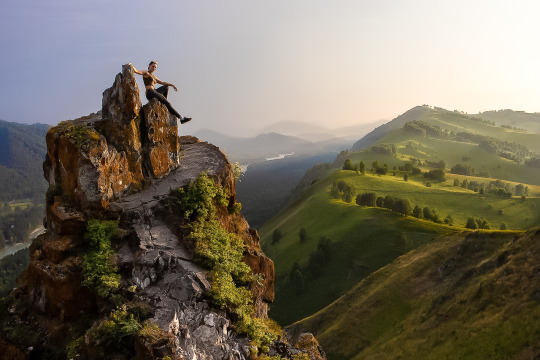
There are many such “magic fingers” all over the world — a giant rock ledge on a mountain, pointing to the sky. But ours is also with a marigold, so they love to look at it in the Altai.
According to legend, this is the finger of a villain named the Devil. He came to these lands to capture them, but one of the brave Altaic warriors was able to fight back. The devil was trampled into the ground, and only his petrified finger remained on the surface. According to another version, the enemy was repulsed by the Moon itself — it descended to the Earth and drove our enemy so deep that only a finger and a nail remained.
The Devil’s Finger is really an amazing place — esotericists believe that a great power is stored in the rock, which can cure infertility and energize. Do not be lazy to go up and see what kind of view opens from the observation deck: the valley of the Katun river and the entire Altai at a glance.
the rapids of a mountain river:

How to get there: from Biysk through the village of Souzga about 114 km. The reference point will be a telephone tower installed near the mountain.
The Katun river — the hostess of Altai
“Mistress” — this is how its name is translated. The largest river of the Republic originates at the slope of Belukha and rushes away for 688 kilometers. On its way there are rapids and boulders, which then turn into flat areas, and the total height difference along the course of the current reaches two kilometers! This is due to the” restless nature “ of Katun: it flows softly, then rumbles between the stones. The river crosses all types of Altai landscape, so the animal and plant life along it is very diverse.

In the area of Biysk Katun meets Biya — the confluence of these rivers is considered one of the most picturesque in the Altai! Katun changes its color throughout the year, acquiring the famous turquoise hue in early autumn.
Hundreds of thousands of tourists flock to Katun every year: some-to relax on its banks in a tent or at a recreation center, others-to test their strength by rafting on the river. Most rafting routes start in the Katun nature reserve.
rafting on the Katun river:
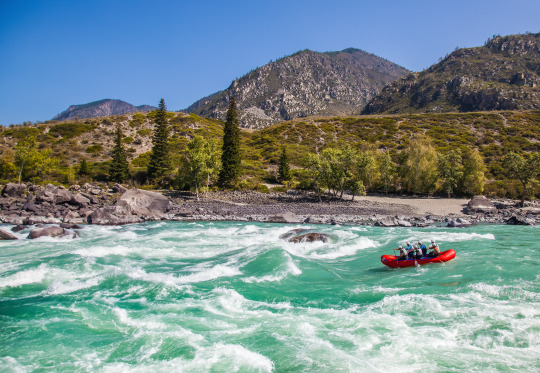
Katunsky reserve is a border area, so you need to get a pass in advance before visiting it. To enter the reserve, you also need to get a permit — you can do this in its administration, which is located in the village of Ust-Koksa. Most of the river downstream has free access.
The coordinates of the source of the Katun: 49.779 318, 552 86.592.
Chike-Taman Mountain Pass
Mountain pass… ract. Now a new, good road has been laid here. At the same time, the preserved old trail, which zigzags along the neighboring slope, almost overgrown, adds color to the already gorgeous view of the huge Terektinsky ridge, which opens from the observation deck.
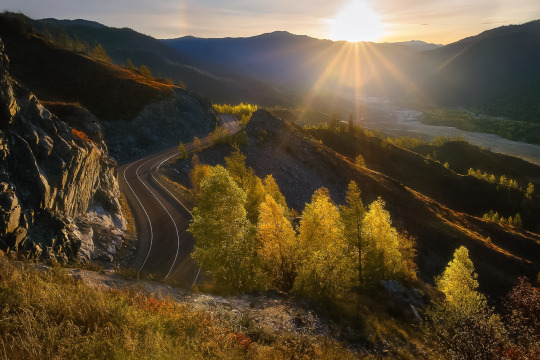
the old road of the Chike-Taman mountain pass, it is still possible to drive along it. It is part of the ancient Great Silk Road:
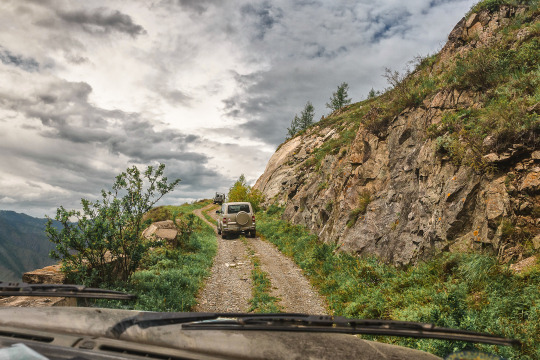
How to get there: the Pass is located on 685 km of the Chuysky tract, 320 km from Biysk and 75 km from the Seminsky pass. The ascent, as well as the descent, is four km.
sightseeing tour of tourists on horseback along the preserved from ancient times section of the Great Silk Road from China to Europe in the area of the Chike-Taman pass:
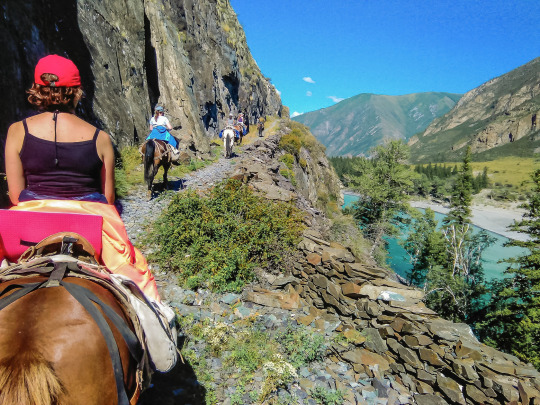
Geyser lake
This small lake, located near the village of Aktash, does not freeze even in winter. Its water has an unusual pattern formed by circles of blue clay-they are carefully “laid out” on the bottom of the underwater keys. The drawing is not static and changes throughout the day.

Now the lake is the property of the camp site “Little Paradise”, which recently leased it for 20 years. Every year this place becomes more and more popular with travelers, so you should come here early in the morning to catch up before the arrival of tourist groups. And it is best to stay for a day at this camp site, then you can easily choose a time period for viewing the Geyser lake more convenient. The camp site is not expensive, spending will not hit your pocket. Passage to the lake is paid: about 50 rubles (less than one Euro), guests of the camp are free of charge.
Coordinates: 50.290 140, 87.673 125.
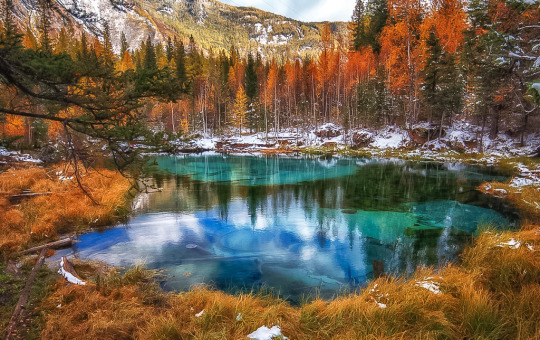
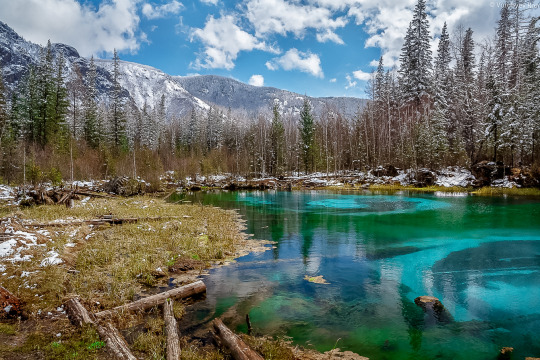
The Ukok high plateau — is a mysterious place of power
It is located in the very South of the Altai Mountains, near the border crossing of four countries: Russia, China, Mongolia and Kazakhstan. Here, at an altitude of more than 2200 meters above sea level, 150 archaeological monuments were discovered: prehistoric rock paintings-petroglyphs, deer stones, burial mounds of the Pazyryk culture, Scythian graves.


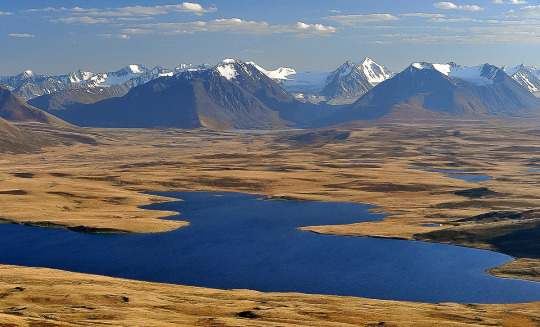
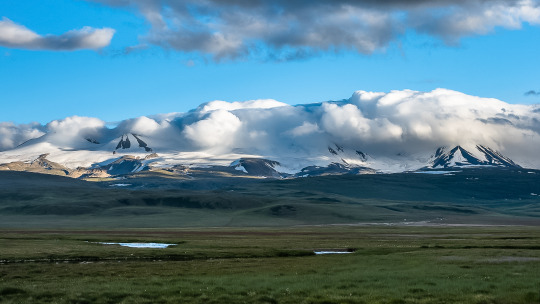
In 1993, archaeologists unearthed a mound that perfectly preserved the remains of a female mummy more than 2,500 years old. She was named the “Princess of Ukok” and taken to the soran Museum of archeology and Ethnography in Novosibirsk. In 2012, the “Princess�� was returned to Altai, and since 2014, the local Council of elders has been seeking to re-bury the find: according to the elders, natural disasters have struck Altai because of the mummy being disturbed.
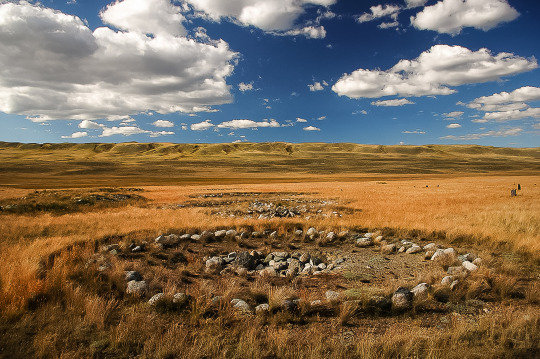
On the territory of the plateau there is a natural Park “Ukok”, which is divided into three zones: one of them prohibits any activity other than scientific, the other allows only limited and regulated access, and only the third is available to travelers. The fauna of the plateau untouched by civilization is very diverse: here you can easily see a wild horse, a wolf, a Fox and even a snow leopard! And in the sky above the silent landscapes soar eagles, Golden eagles and black storks.
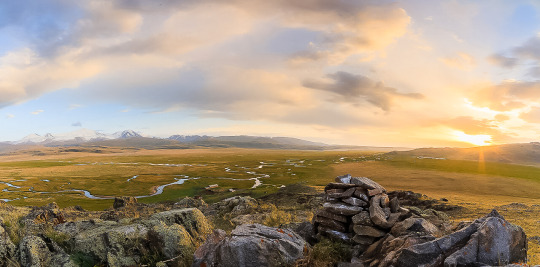
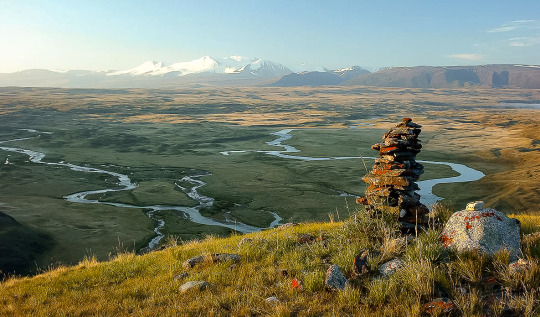
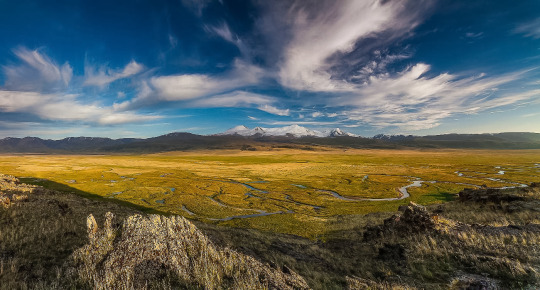
Walking tours and yoga tours are organized on the plateau, esotericists often come to this place, and shamans conduct their rituals here.
Coordinates: 49.360 813, 88.76 642.
Lake Teletskoye
Perhaps the most popular attraction of the Altai mountains. It is the largest lake in the region and the second largest freshwater reservoir in the country after lake Baikal. The depth of the Teletskoye reaches 325 meters. Three small villages Nestle on its banks: Yaylu, Iogach and Artybash. To relax and swim, choose one of the hotels on the southern shore: in summer, the water temperature rises to +17°C — + 20°C, but in the North, in the area of Artybash, the lake remains cold even in hot weather-about +10 °C.
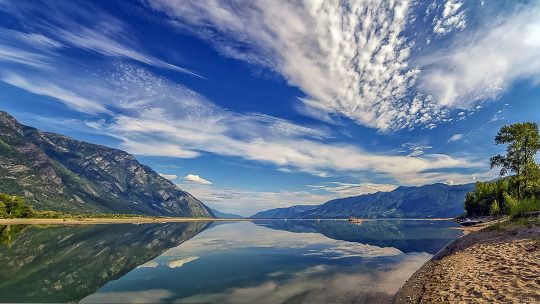
The water in Teletskoye is so clear that even at a depth of 15 meters you can see the stones lying on the bottom. You can set up a tent on the beach or enjoy the scenery of the lake by going for a ride on the ferry: it follows from Cape Kyrsay, which is on the southern coast, to the pier in Iogach — 78 kilometers of the way along the water surface will give you a pleasant experience and gorgeous photos!
Coordinates of Cape Kyrsay: 51.363 980, 87.760 251
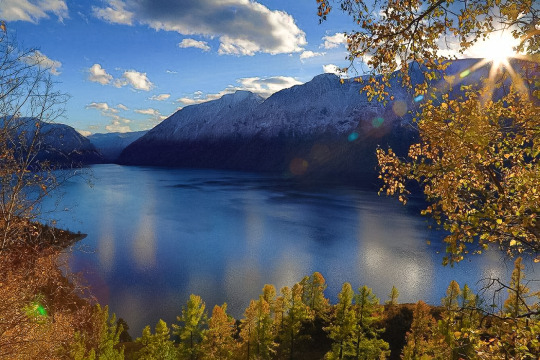
Teletskoye lake is famous for its cold water at any time of the year, its gigantic size, many types of fish and amazing landscapes. Here you can come to one of the camp sites or savage, you can fish, go on excursions to the nearest mountains, admire the cascades of waterfalls or even meditate-choose what you like, just do not forget to take warm clothes! Despite the fact that Teletskoye lake is one of the most popular places in Altai, many travelers are forced to avoid it if they choose attractions only along the Chuysky tract. Those who get to Teletskoye lake do not regret the time spent on the road. Even hotels and camp sites that have grown up like mushrooms on the coast do not violate the special atmosphere of this place — it is easy to let go of worries, forget about sorrows, and learn to recharge from nature.
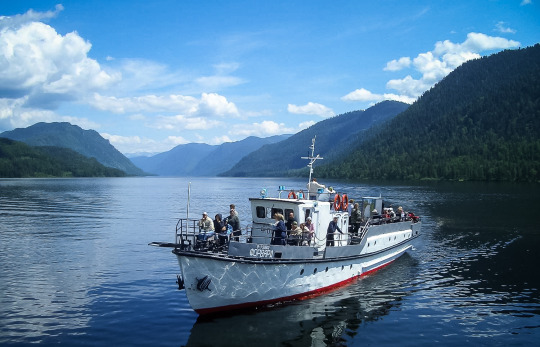
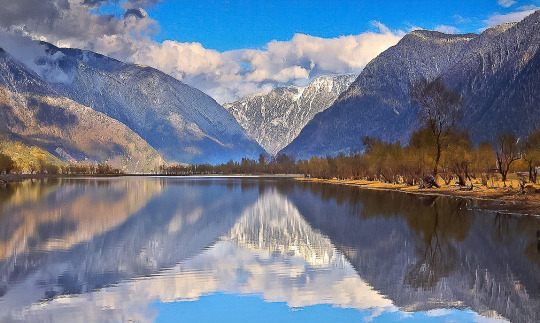
The locals consider the lake Holy and call it the Golden lake-Altyn-Kel in the local dialect. Esotericists believe in its magic power, tourists come from all over the world to Altai, just to see Teletskoye lake and experience its magic for themselves. Do you want to see what this place does to you?
Golden lake-sunset on lake Teletskoye:
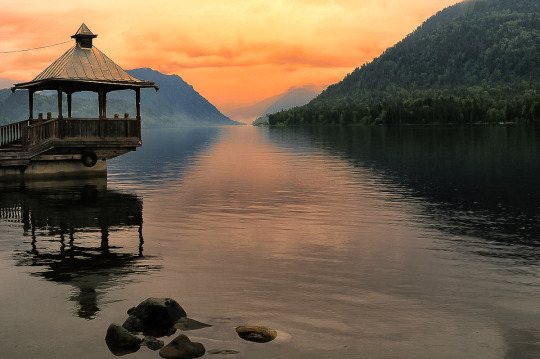
Most of the lake is included in the Altai State Natural Biosphere Reserve, so to visit it, do not forget to issue a pass — it is easy to get it in the village of Artybash or the village of Yaylu.
What to see in the surrounding area: Korbu and Chodor waterfalls, Karagay Bay, Chulyshman valley, zoo and ethnopark in Artybash village, Tilan-Tuu and Kokuya mountains (the latter can be reached by lift).
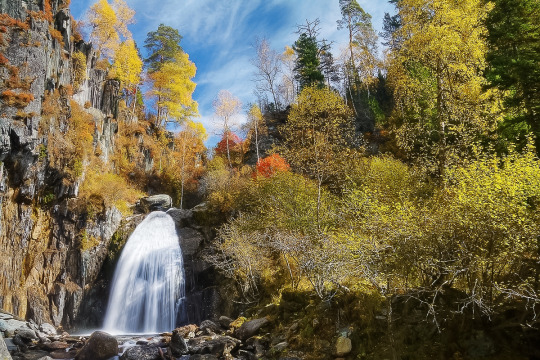
How to get there: the most convenient way to get to Teletskoye lake is from Gorno-Altaisk-it is 269 km to the nearest village to the lake, Artybash. regular buses run along the route. You can get to the South Bank by ferry, which runs from Artybash a couple of times a week, or by a beautiful circular road through the entire Chuisky tract and the terrible Katu-Yaryk pass. The last part of the path is accessible only to all-terrain vehicles.
Multinskoe lake
So we got to the most popular place among tourists in the classic lists of “What to see in the Altai” — the Multin lakes. There are five of them: Lower, Middle, Upper, Transverse and Strong (very logical, Yes). Most often, tourists include the first three in the route. At the same time, the most popular is the Lower Multinskoe lake. It is the largest, it is easier to get to it, there are camp sites nearby and everything you need for a comfortable stay by the water.
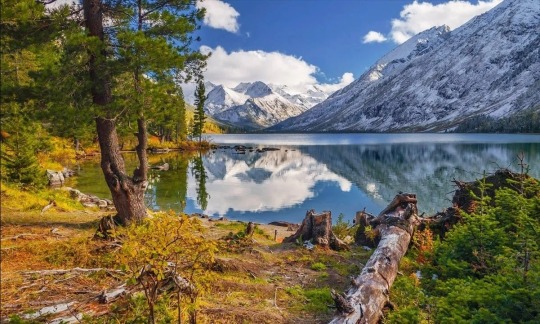
The most beautiful thing is waiting for you between the Lower and Middle lakes — this is where the water cascade “Multinskiye shumy”is located. Then the road leads to the Upper lake. It is located on the territory of the Katunsky reserve, so you will need to pass through the cordon, coordinate the route with the Rangers and pay a small fee.
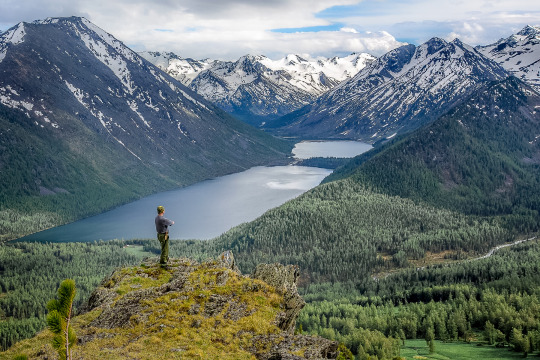

How to get there: from Biysk to the Multin lakes 535 km through the Seminsky pass.
Take care of your documents in advance! Don’t forget to take your passport — there is a Kazakh border near the lakes, they can check your documents. Citizens of the Russian Federation need only a passport, but guests of the country will also have to get a pass. It is issued on request in the Department of the Federal security service of Gorno-Altaisk.
The Petroglyphs Of Kalbak-Tash
A large complex of ancient rock paintings has more than 5 thousand images. According to scientists who have studied Kalbak-Tash, the drawings were created by people who lived here from the Neolithic era (IV-VI centuries BC) to the middle ages (VIII-X centuries ad). on the stones you can see figures of animals that inhabited the Altai several thousand years ago, hunting scenes and various, including solar, symbols. The people who carved them on the rocks used both stone and metal tools. Researchers refer well-preserved runic inscriptions to the ancient Turkic epoch. Some of the depicted stories can be easily correlated with the well-known Altaic myths.
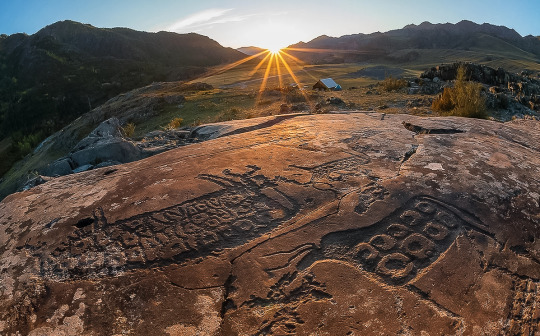
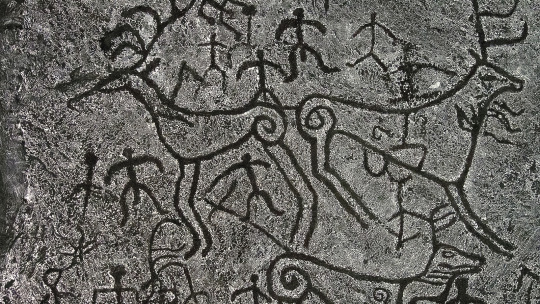
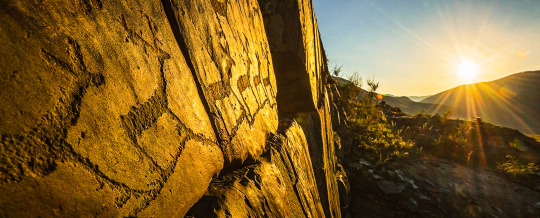

How to get there: the rock art complex is located on the right Bank of the Chui river near the Chuisky tract. After the “723 km” mark, turn left between the fourth and fifth poles of the power line and walk about 20 meters to the rocks.
Katu-Yaryk Mountain Pass
Ready for the most spectacular serpentine ride of your life? The pass is only thirty years old — until 1989, there was only a steep horse trail, now there is a dirt road. Climbing it is wildly scary, but all this will be forgotten as soon as you can look at what opens from above — the winding path of the road, colorful mountains, stormy mountain streams, waterfalls and the tops of centuries-old trees. It’s breathtaking!
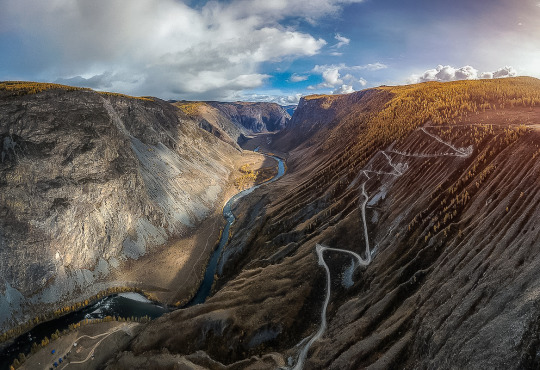
Katu-Yaryk in numbers:
Height from the bottom — 892 m;
The average slope of 18% (10°);
Slope steepness-70% (35°);
Length-3.9 km;
The number of turns is 9.
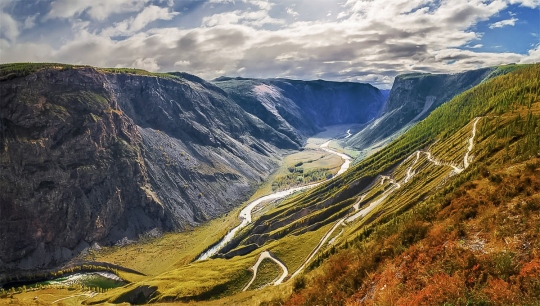
How to get there: by ferry across lake Teletskoye (the cost of crossing one car is 10,000 rubles). Then go along the Chulyshman valley for about 20 kilometers. The second option is from the village of Aktash, which is located 100 km from katu-Yaryk. Accordingly, this road leads to the southern shore of lake Teletskoye. It is desirable to go in high-traffic vehicles. Low cars often lose their bumpers on the road, and non-four-wheel-drive cars are not able to climb to the top of the katu-Yaryk mountain pass on their own due to too strong a slope and rocky obstacles on a narrow road cut through the rock. However, in the tourist season, a four-wheel-drive truck from the nearest tourist base is always on duty at the bottom of the pass,which for a small fee will drag the monoprivod car up.
Big Chulchinsky waterfall or Uchar
The highest and most unusual waterfall in the Altai mountains! Its waters loudly and spectacularly cascade down from a height of 160 meters. It is located on the territory of the Altai State Reserve.
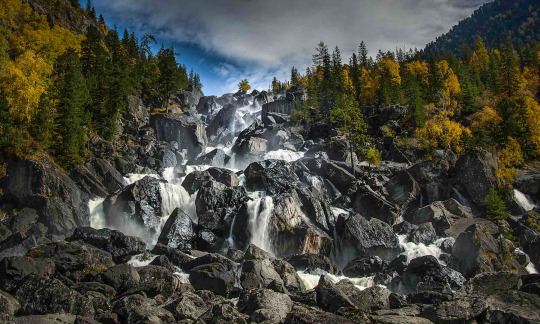
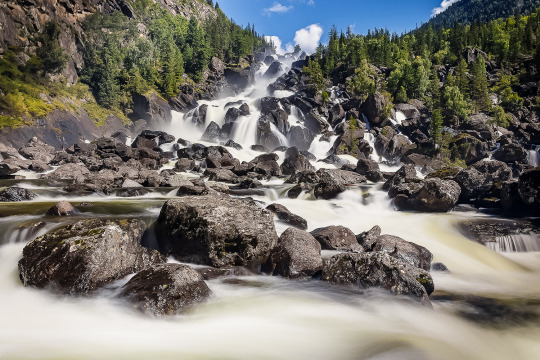

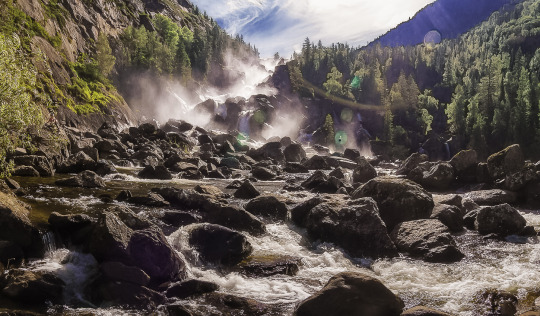
“Uchar” is translated as “unapproachable”, and the waterfall justifies this name: the way to it through the picturesque expanses of the reserve takes about four hours and requires good physical training — the trail is quite steep, some sections are duplicated by safety cables. However, you can often meet children and elderly people at Uchar. No special skills are required for visiting.
Coordinates: 51.118 079, 88.91 675.
Shavlinskoe lake
They were formed as a result of the melting of ancient glaciers. The lakes are located in the heart of the North Chui Mountain Range and are considered the most picturesque in the entire Altai! Their water has a fantastic bright turquoise color, and from the banks there are incredible views of three Altai peaks at once, whose names are Dream, Beauty and Fairy Tale.
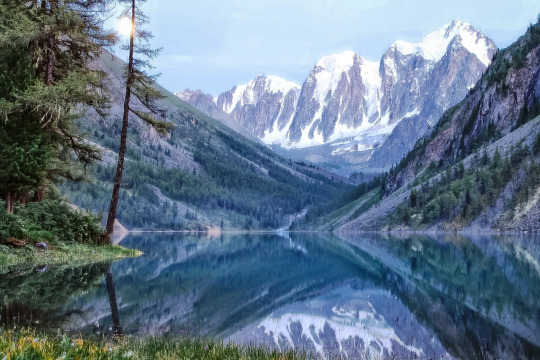

You can get here as part of walking tours organized by companies in Biysk and Gorno-Altaisk. The route starts from the village of Chibit and lasts about a week.
Coordinates: 50.106 689, 87.410 589.
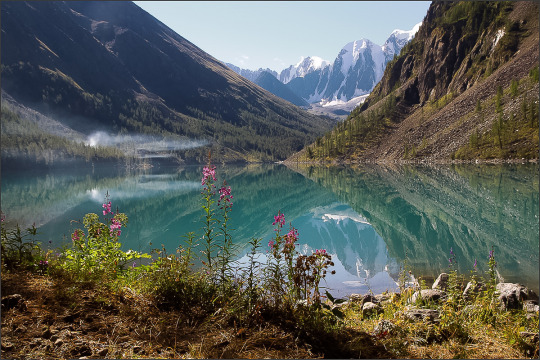

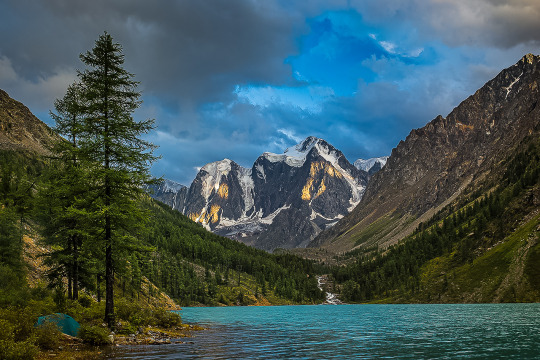
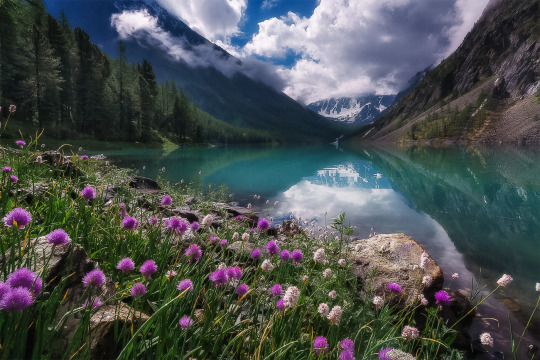
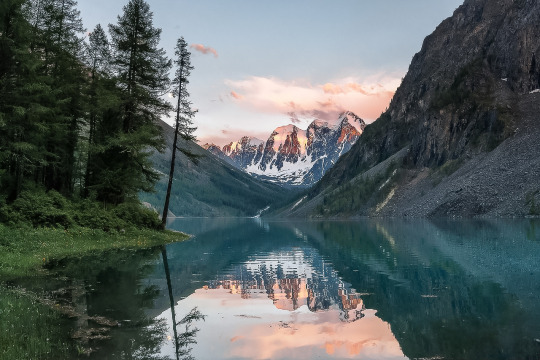

Kek-Tash cave is one of the deepest in the country
Kek-Tash, translated from the Altai means “Blue stone.” This name was given to the cave because of the unusual gray-blue color of its limestone vaults. Bizarre stalactites and stalagmites, labyrinths of caves with dead ends, lakes-inside Kek-Tash a whole underground world with fantastic landscapes! There are several large halls that are connected by narrow passages. This is the deepest cave in Siberia, its length is 2.3 kilometers, and the tunnels go deep into the mountain for 350 meters.
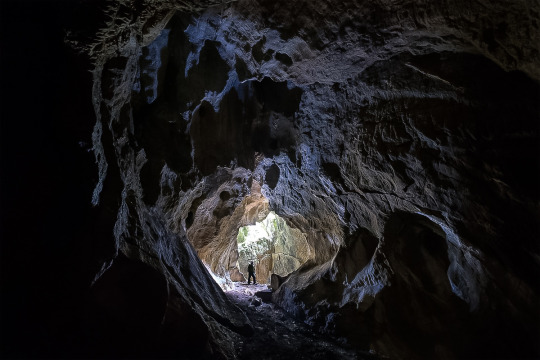

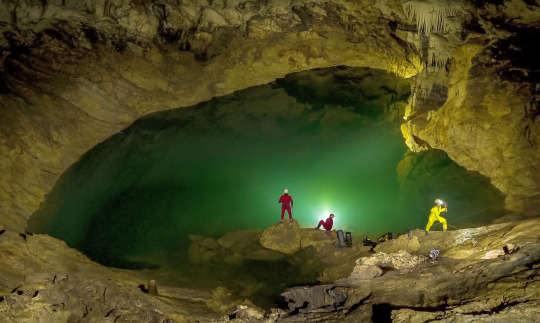
Kek-Tash is located in the North of the Shebali district, and you need good physical training and special equipment to visit it. Basically, come here if you like sports, tourism, diggers and explorers.
The coordinates of the entrance to the cave: 51.728 933, 85.656 417.
Belukha mountain is the main peak of the Altai
The highest peak in Siberia got its name because of the non-melting snow cap on the top. The locals also call it Uch-Sur — “Home of the Three Gods”. This mountain can be seen on the coat of arms of the Altai. The famous Russian traveler and esotericist Nicholas Roerich depicted its southern slope in one of his paintings. He was sure that the entrance to the mythical land of Shambhala was hidden here. “Lady of the Altai” — so the artist called his mighty snow-covered Muse.
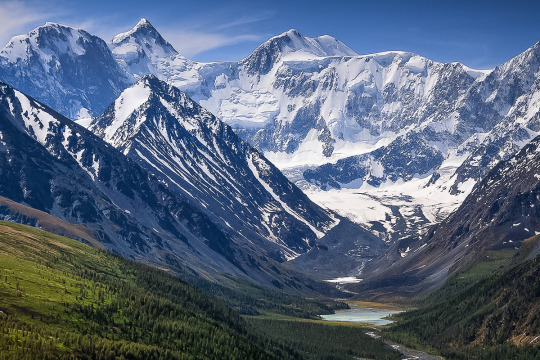

the chapel under Belukha mountain:
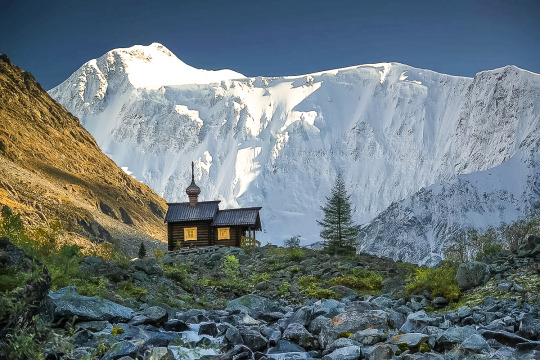
The beauty of Beluga is best viewed from the Akkem lake. Climbing to the top with a guide costs about 30 thousand rubles per person. You can also see the mountain from a bird’s-eye view by participating in a group helicopter tour from Gorno-Altaisk. It lasts 7–8 hours, and the cost per person is about 28 thousand rubles.
Climbing Belukha will not be easy, but the tests will pay off with a vengeance — on the way to the top (height-4506 m) you will meet blue lakes with crystal-clear water, unique plants — at the foot of the mountain there are dense coniferous forests, birches, tundra lichens, berry bushes and flowers that are included in the Red book.

The best season to climb the mountain is summer, but even in July, be prepared to get caught in snow. The climb will be difficult and exhausting, and if you are not lucky with the weather, it will be delayed. Yes, it is better to go on such a trip with an experienced instructor or group.
Apart from the road to the bottom of the mountain and the time for acclimatization, the ascent takes about two days. On the first stage, pass the “Watermelon” glacier, Delaunay pass and Mensa glacier, and on the second day they already storm the top.
The coordinates of the vertices: 49.807 679, 023 86.590.
How to get to Altai?
From Moscow to Gorno-Altaisk. Almost all domestic airlines have direct flights to Gorno-Altaisk, and if you buy tickets in advance, you can snatch quite profitable tickets even for direct flights, and with a transfer so much the more. The flight duration is from four to five hours.
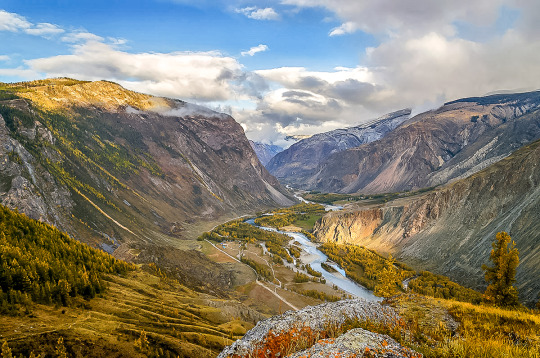
From Moscow to Biysk. An option for romantics and lovers of sleeping under the sound of wheels: by train to Biysk, the road will take almost three days, but when did this stop us? When you look at the ticket prices and calculate how much you will save in comparison with the plane, do not forget to add the expenses for food on the road. And in General, familiarity with Russian Railways will expand your horizons and prepare you for difficulties :)
From Saint Petersburg to Gorno-Altaisk. There are no direct flights to Gorno-Altaisk, so you will have to go with a transfer in the capital. If you can snatch cheap plane tickets (in the spring of 2020, there are many such offers), it will be both fast and profitable. If there are no successful plane tickets, then choose a train — one night, and you are there.
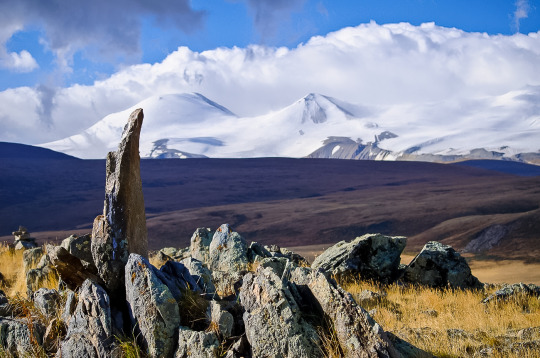
Via Novosibirsk to Gorno-Altaisk. This option is ideal for tourists who start their journey not from Moscow — flights fly to Novosibirsk from almost any city in Russia (and besides, they fly for cheap!), and then you can get by plane or bus to Gorno-Altaisk.
Especially worth noting is Barnaul — the largest transport hub relatively close to the Altai Mountains.
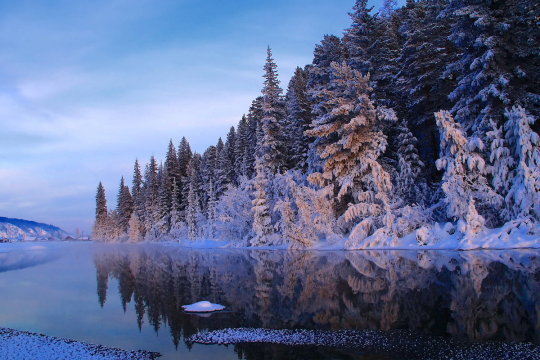
Going on a trip to the Altai is easier than it seems — in Biysk, Barnaul and Gorno-Altaisk, you can rent a car (with or without a driver), roads to the main tourist sites are paved, camp sites, hotels are built, and camping sites are equipped. This world is waiting for you!

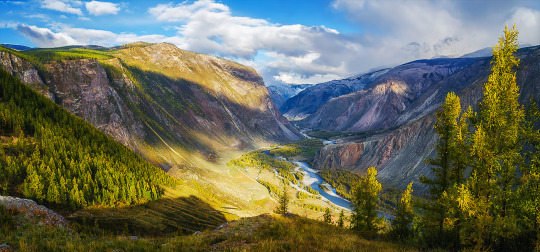

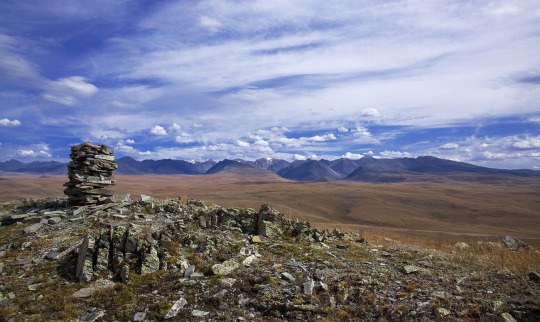
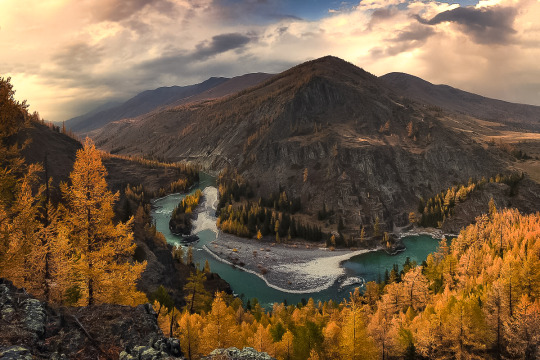
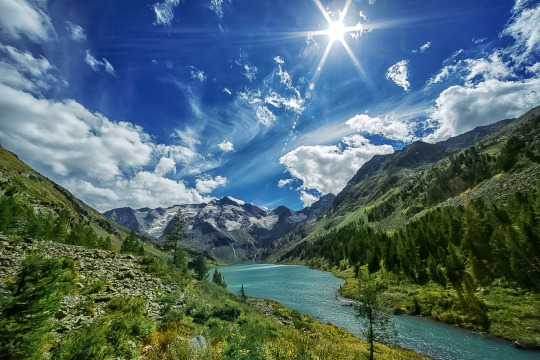
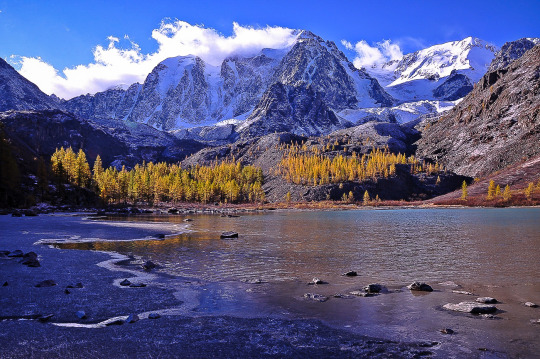
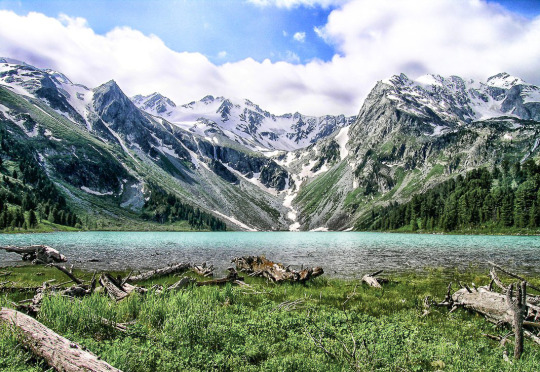
1 note
·
View note
Text
Budapest and My Heart
What a love story it was

I don't think we realise just how much is out there. Beyond the walls of our houses and further than the streets that wind between our local shops. I don't think we realise - though sometimes we think we might - just how spectacular this world of ours is. We forget that places are there for us to fall in love with, just as people are. And like people, these towns and cities and countries capture your heart with their brilliant personalities and the romance between person and place begins.
That was something that I thought about, thousands of feet in the air.
It really, truly, occurred to me that we need to make the most of this planet, when the plane had just taken off. During our ascent into the clouds, I could see everything. My hometown, hidden in the night and yet lit up like it was a reflection of the stars above. Everything was light, a network of the tiny glowing streetlights and buildings and homes. And that was exactly what Budapest looked like from above, too, two hours later. It was breathtaking. And yet, the next morning when the sunlight touched everything again, it was more breathtaking still. Because even though both cities were similarly beautiful at night, in the daytime, Budapest was beautiful in its own unique way.
The buildings were made of stories, of history and of elegance, and they sat so neatly alongside the Danube. In the distance, there were hills with even more wonderful buildings and statues and monuments, watching over the boats that sailed along the river. The people of Budapest were so welcoming and kind. You could tell that they loved their city, that they were proud of everything it had to offer. There was so much to do and to see, and even though the air was chilly, the sky was blue and there were people everywhere. And there were so many stories and languages and experiences that people were sharing with one another. Students on their first trip there, getting drunk with the locals. Couples returning to their favourite place in all the world, seeing sights that need to be seen more than just the once. There was a little bit of everything. Outdoor thermal spas, zoo cafes, boat trips, city tours. Cafes and restaurants and street food. A weekend was not enough time for it all.
And yet, it only took a weekend for me to fall in love with it. I don't know exactly what it was - or maybe that's the point, it was a combination of everything - that made me give a piece of my heart to it. But there that piece shall stay, in its new home of Budapest. I think sometimes there are parts of the world where you are just meant to be. Maybe not always, maybe not permanently, but at some point, inevitably. Perhaps in a parallel universe, it is my home. And that's why I feel connected to it, even miles and miles away.
I hope to visit Budapest again one day. To meet more of its locals, to try more of its food, to breathe more of its Hungarian air. And I hope that more people get to experience it, too. To fall for it for many different reasons, and many that undoubtedly are the same. But for now, this love story shall remain long distance, one that travels over the ocean and across the world. Here’s to all the people of Earth who are in love with this amazing planet. What a love story it is.
#Budapest#love#city#travel#Hungary#writing#heart#holiday#trip#Europe#love story#home#place#person#travelling#world#Earth#planet
2 notes
·
View notes
Text
0 notes
Text
0 notes
Text
India’s coronavirus lockdown: One man’s agonizing 1,250-mile journey home … on foot
But he didn’t stop walking. He couldn’t.
The 26-year-old migrant worker was in the heart of India and only halfway home.
With no way to survive in the cities, and India’s vast railway network mostly shut down, many made the extraordinary decision to walk thousands of miles back to their families.
Many didn’t make it. In one incident, 16 laborers were run over by a freight train as they slept on rail tracks. Roadside accidents took the lives of others. Some died from exhaustion, dehydration or hunger. Those picked up by police were often sent back to the cities they had tried to leave.
Chouhan knew the risks. But on May 12, he decided to defy India’s strict lockdown laws and begin the 1,250-mile (2,000-kilometer) walk from the tech hub of Bengaluru, formerly known as Bangalore, to his village in the northern state of Uttar Pradesh.
He’d hoped to hitchhike much of the way, but with police checking trucks for stowaways, drivers were demanding fees beyond Chouhan’s budget. For 10 days, he’d have to dodge police check points, survive on tea and biscuits, and walk on aching feet.
“I don’t think I can forget this journey through my life,” he says. “It’ll always carry memories of sadness and anxiety.”
A 3 a.m. getaway
Chouhan moved to Bengaluru last December to work as a mason on a construction site.
In his home village of Tribhuvan Nagar, on India’s border with Nepal, he earned 250 rupees ($3.30) a day. In Bengaluru, he could double that.
He and his brother, who worked in another state, sent home about 14,000 rupees ($185) a month — enough to sustain their family of 11, including Chouhan’s two young children and his elderly parents, living in a thatched roof house set amid sugarcane and wheat fields. His nephew Arvind Thakur joined Chouhan in the city as soon as he turned 14, the legal age to work in India.
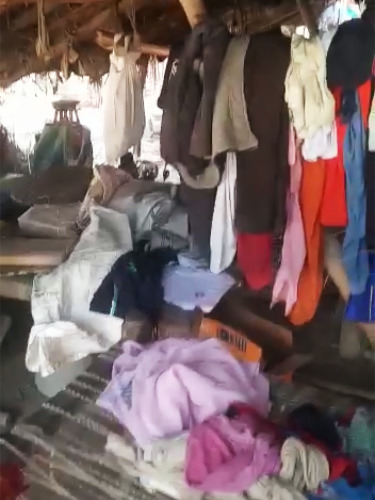
A video of Rajesh Chouhan’s house. 11 people share this space. “When it rains, we get wet even inside the house”
By the time Chouhan, his nephew and nine other migrants from their hometown had decided to leave Bengaluru, the country had been shut down for weeks. Some rail services resumed on May 3, allowing interstate travel — but only subject to a laborious approval process.
Migrants were told to register their travel plans at police stations. By May 5, more than 214,000 people had registered to leave Karnataka state, of which Bengaluru is the capital. However, barely 10,000 people got tickets as there was limited train service.
Normally Chouhan pays 300 rupees ($4) for the 48-hour trip home in the lowest carriage class, but during the pandemic that price soared to 1,200 rupees ($15.90). State police were assigned to sell tickets and keep order at police stations packed with travelers desperate to get home.
Police in Bengalore told CNN they resorted to using batons to clear the crowds when sales for the day ended. “We were beaten many times. Just because we are poor, doesn’t mean we can’t feel pain,” says Chouhan.
After spending five days outside a police station trying to get a ticket, Chouhan and his fellow villagers decided to walk. They didn’t dare tell their families.
“We were beaten many times. Just because we are poor, doesn’t mean we can’t feel pain.”Rajesh Chouhan
“My father is severely diabetic and it would take a toll on him and my mother if they found out that we were walking home with no money,” Chouhan says. “They’d cry until our return. All of us decided to tell our families that we were waiting for a train.”
He packed four shirts, a towel and a bed sheet in his backpack, along with a couple of water bottles. In his wallet was 170 rupees ($2.25).
At 3 a.m. on May 12, Chouhan slipped out of the single-room tin shed he shared with 10 other people and took his first step towards home.
Getting out

By the time Chouhan left, police checkpoints had been erected across the city. Authorities had not anticipated the rush of migrants wanting to leave and clarified that registration applied only to those “stranded” — not migrant workers. Unauthorized interstate travel was banned.
As Chouhan’s group walked across the city, they were picked up by police and taken to the station where their boss — who never wanted them to leave — would pick them up. While migrant workers have rights under Indian law, often they are unaware of them and exploited by employers.
At noon, police officers changed shifts and the group was left unattended. “We ran out of there,” Chouhan says. “We ran for two kilometers or so until we felt we were safe.”

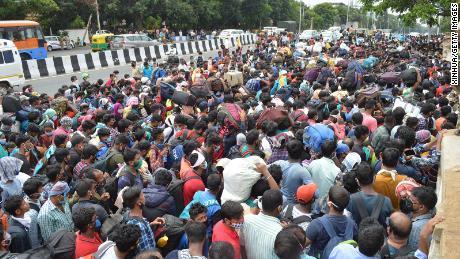
Following railway tracks to avoid police on the roads, the group walked through the night, with other migrants, until they entered Andhra Pradesh at 1 a.m.
After 46 hours, they had crossed the first of the five state borders they would encounter. They had traveled just 74 miles (120 kilometers).
Hope, solidarity and hunger
Chouhan’s group of 11 migrants had nine smartphones between them, and they used Google Maps to navigate their route. They used the flashing blue dot to see if they were roughly walking in the right direction.
To conserve battery power, only one person would have their phone switched on at a time, and they took turns sharing GPS. There were few places along the way where they could charge their phones.
The first part of their journey traced National Highway 44 — a long, open road that slices India neatly in two, running the length of the country from Tamil Nadu in the south to Srinagar in the north.

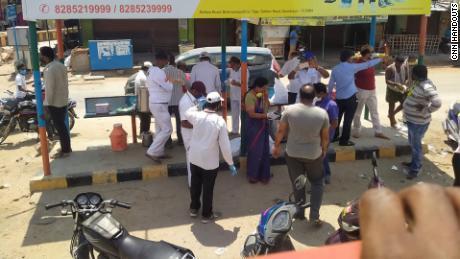
This road would take them to Hyderabad, the city of 10 million people that was to be the first big landmark of their journey — and where they’d heard it would be possible to hitchhike the rest of the way home.
As temperatures topped 40 degree Celsius (104 degrees Fahrenheit), Chouhan walked about 5 miles (8 kilometers) an hour, taking a brief rest every two hours. He aimed to complete about 68 miles (110 kilometers) a day. “There was temptation to rest or to nap,” he says. “But we were aware that it became more difficult to walk each time we sat down.”
Along the way, they’d see other groups of migrants heading for the impoverished western states of Odisha, Chhattisgarh, West Bengal, Bihar and Uttar Pradesh, which supply India’s cities with much of their migrant labor force.
On the road, Chouhan says traditional divisions of caste and religion — deeply entrenched fault lines in India’s rural hinterlands — disappeared. His group of 11 spanned various castes from the same village. There were Brahmins and Thakurs, who are considered upper castes, and Chamars, who are among the lowest. On the long walk home, it didn’t make a difference.
When Chouhan’s slipper broke on the second day, the group pooled their funds to buy him a new shoe.
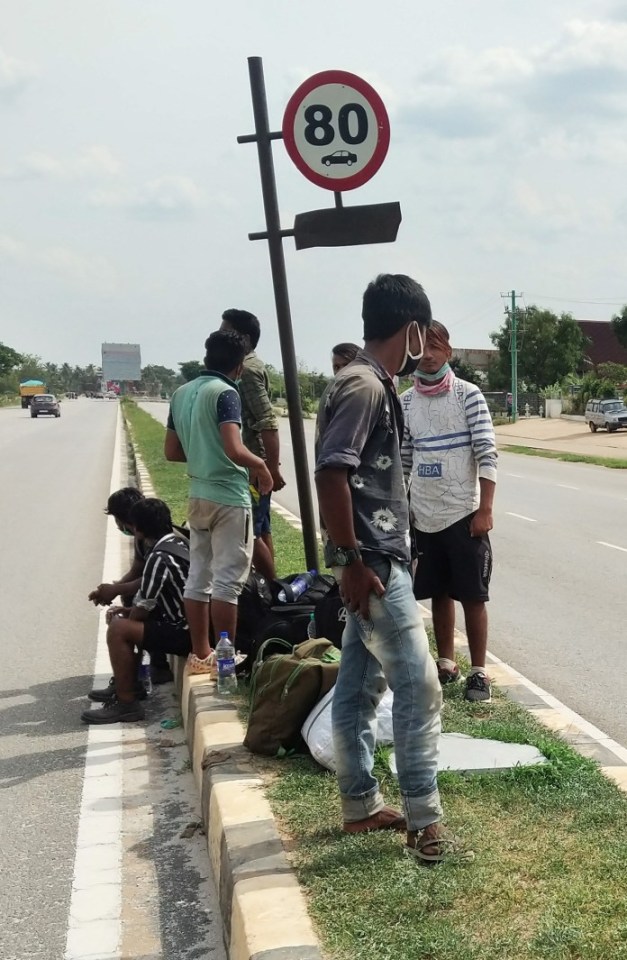
Rajesh Chouhan and his friends wait on the divider hoping for a truck to drop them across the border.
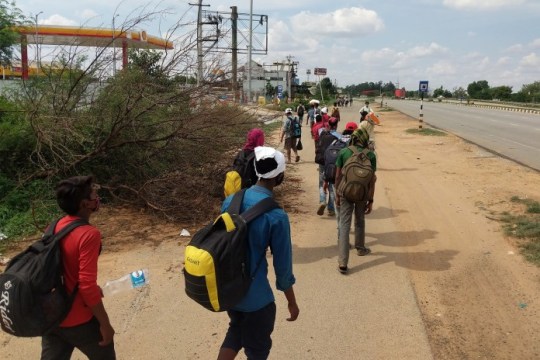
After asking locals about ways to bypass the upcoming police checkpost, Rajesh’s 11-member group heading to Gonda join a 17-member group heading to Chattisgarh state. The group peeled off the highway and walked through fields and forests to avoid the police.
But by day three, they had not had a full meal since they left Bengaluru. Each person had started out with between 150 rupees ($2) and 300 rupees ($4). Instead, they’d buy 20 biscuits for 100 rupees ($1.32) and ration them through the day. “We had to save every rupee in case we needed it later during the journey,” says Chouhan.
“Our stomachs would rumble. We’d eat a biscuit to keep it quiet. We were hungry, but we had no choice. We had to save every rupee in case of an emergency.”
Around 8 a.m. that day, they stopped on the side of National Highway 44, thinking they’d rest for an hour. They slept for eight, oblivious to the din of highway noises and blaring trucks.
When they woke up at 4 p.m. Hyderabad was 250 miles (400 kilometers) and one state border away.
Crossing borders
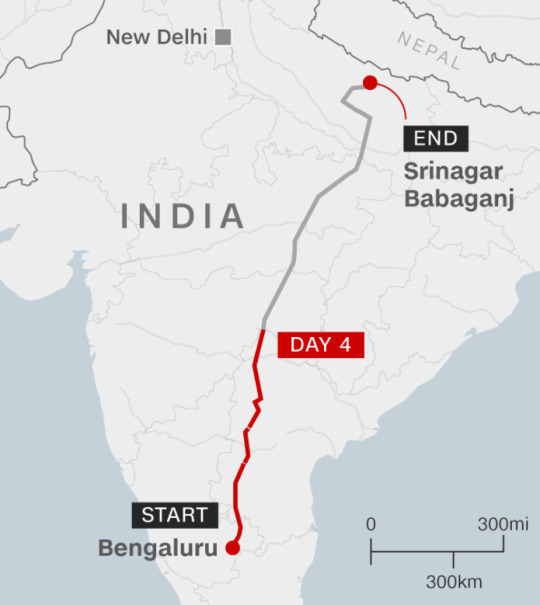
With Hyderabad in his sights, Chouhan walked through the night. But when his group reached the town of Kurnool at about 10 a.m. on day four, a police checkpoint blocked the bridge they had to cross to reach the city.
Chouhan saw a stream of migrants following a winding path along the river and followed them. About 2 miles (3.2 kilometers) away, hundreds were crossing the river on foot.
Chouhan and the others hesitated — they didn’t know how to swim. “Men, women, children, the elderly were crossing the river,” he says. “(We thought) if they can do it, why can’t we.”
After a long, hot summer, the river was only 3 feet (1 meter) deep. Chouhan held his bag over his head, and one of the tallest men in their group carried his 14-year-old nephew.
“We were so scared we’d be washed away. But we kept telling ourselves this was the only way home. This 100-meter stretch was perhaps the most scared we’ve been on this journey,” says Chouhan.
Back on the highway, truckers were asking as much as 2,500 rupees ($33) per person to take them towards Uttar Pradesh. “They told us that if the police caught them, they would have to pay big penalties. They didn’t want to take the risk without getting paid in return. We had no option but to walk,” says Chouhan.
But others were more charitable. One old man offered them their first full meal in four days. A truck driver took pity on their blistered feet and offered them a lift. He was transporting rice across the border and they slept between the gunny sacks, as he drove them around the outskirts of Hyderabad.

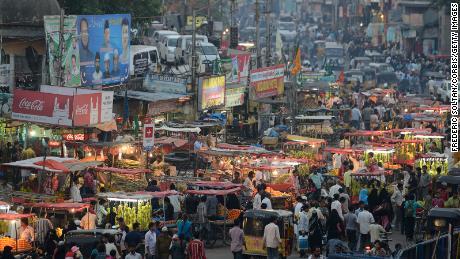
After they passed the Telangana-Maharashtra border, they had another stroke of luck — a villager took them to a school where NGOs were giving food and water to migrant workers.
More than 300 migrants were eating when the police arrived.
“They started to abuse us,” Chouhan says. “They said we were not following social distancing and we should sit 10 feet from each other. They attempted to disperse the crowd and told the organizers to stop giving out food.”
But the migrants outnumbered the police. “We started to shout back. Some migrant workers even started to push the police, and the police retreated towards their jeep,” he says. “We were angry. They (police) don’t help us at all — they don’t help people help us.”
Pandemic and death on roads

When Chouhan was in Bengaluru, he had heard about the pandemic that had brought India to a halt. But he says his understanding of it was poor. When he left on May 12, Bengaluru had just 186 confirmed cases. As he walked home, Chouhan chatted to other migrants, huddled in trucks and tractors, and ate meals in close quarters, breaking social distancing regulations.
There is little data on how the migration of urban workers has impacted the spread of coronavirus in India. Returning migrants have tested positive for the disease in large numbers in many states, but it is not known if they contracted Covid-19 in the city or picked it up along the way.
In Uttar Pradesh, India’s most populous state, more than 807,000 interstate migrants were being quarantined by May 24. Of the more than 50,000 tested, 1,569 were diagnosed with Covid-19.
On day five of their journey, the group had a health scare as they approached the central Indian city of Nagpur.
Rajesh’s nephew Arvind Thakur had a fever. “I did get scared,” Thakur says. “I do not understand anything about coronavirus. But the adults told me it cannot be coronavirus as it comes first as a cold and cough. I only had fever. They gave me tablets and I felt better.”
On the highway, the pandemic was a low priority — there were more pressing health concerns: hunger, thirst, exhaustion and pain.
There is no official data on deaths due to India’s lockdown, but a volunteer-driven database set up by a group of Indian academics has been tracking local media reports of fatalities as a consequence of the policy.
By May 24, it had recorded 667 deaths, of which 244 were migrant workers who died while walking home: either through starvation, exhaustion or in rail and road accidents.
“In Bengaluru, I was scared of this illness,” says Chouhan. “Now, all we wanted to do was go home. It was not in our hands if we fell sick during this journey.
“The moment we left Bengaluru, we’d left our fate to the gods.”
The home run
Under the black night sky and thick canopies of the forested areas of Central India that once inspired Rudyard Kipling to write “The Jungle Book,” Chouhan crossed the Maharasthra-Madhya Pradesh border. It was day six.
In Madhya Pradesh, tractors, buses and trucks helped the group along during the day, and hillside villagers provided them with food and even a tanker to bathe in.
Two days later, they reached the border of their home state, Uttar Pradesh. Home was just 217 miles (350 kilometers) away. “We forgot our pain. It felt like we were already home,” says Chouhan.
As they passed Prayagraj, a site central to Hindu spiritualism where the rivers Ganges, Yamuna and Sarasvati converge, Chouhan allowed himself a rare moment of joy.

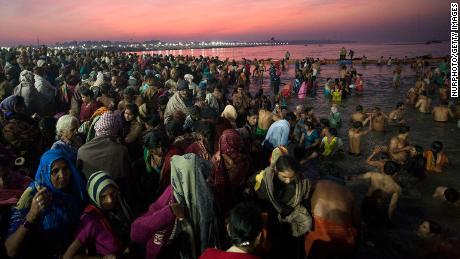
Joining thousands of Hindus, he took a dip in the cool waters, and said a prayer for the group to reach home early.
One day later, their ninth of walking, they reached the state capital, Lucknow.
Home was just 80 miles (128 kilometers) away. Chouhan bought a meal for the first time since their journey began and called his family. “We told them we had come by train to Uttar Pradesh. We would be home in a day,” he says.
The closer they came home, the more tired Chouhan says they felt.
On day 10, at Gonda, 18 miles (30 kilometers) from their village, Thakur’s body gave up. He fell face first into the asphalt. The group revived him by pouring water on his face.
Then, just 2 miles (3.2 kilometers) from home, they ran into the police. Too weak to run, they allowed officers to place them quarantine.
Finally, they were home.
Home and scarred
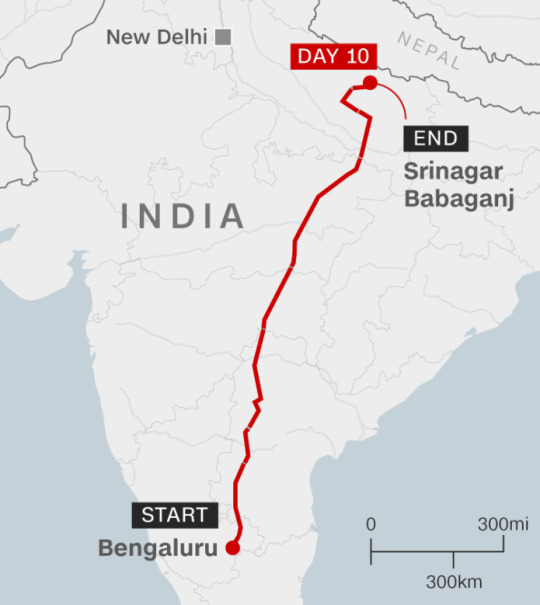
The scars of walking up the spine of India took its toll on their bodies.
Chouhan says he has lost 10 kilograms (22 pounds) throughout the journey. He says his feet have swollen so much it’s a struggle to walk to the bathroom in the school where he is meant to be quarantined for 14 days.
However, in Uttar Pradesh the quarantine is badly enforced.
On May 24, Chouhan says his family was allowed to visit him in quarantine.
His children lunged towards him. And when they hugged tightly, Chouhan says he forgot his pain. He has been allowed to visit his family at their home, and go to the pharmacy to buy medicine, which he took out loans to pay for.
Seeing his thatched-roof house, where his big family sleeps, he says, reminds him how his work in Bengaluru has sustained his family.
Yet on May 25, tragedy struck. Thirty-year-old Salman, one of the 11 who walked from Bengaluru, was bitten by a snake just days after arriving home and leaving quarantine.
He died on the way to the hospital.
More than 45,000 people die of snake bites in India annually. More than 200 people attended Salman’s funeral, including some of the group Chouhan walked with, who were meant to be in quarantine.
Chouhan is mourning the tragedy. Yet he realizes that the poverty in his village, the hunger of his family, and the mounting debt from their medical treatment mean he must eventually return to the city to work.
“When I left Bengaluru, I resolved never to return,” he says. “The best I can do is wait for a few weeks to see if the lockdown is relaxed before heading out again for work.”
Design and graphics by Jason Kwok. Edited by Jenni Marsh and Hilary Whiteman.
Source link
قالب وردپرس
from World Wide News https://ift.tt/2AmAnWa
0 notes
Text
Churches in Munich
I have been living in my second hometown, Munich, for over three decades, and still, I haven’t explored all of its places. No, it doesn’t mean I don’t travel a lot or have no interest in discovering nooks and crannies of my city. It means the town is filled with an infinite number of mesmerizing architectures to see that every time I visit any corner of Munich, it amazed me differently. However, being a Catholic German, I have vast information about churches in Munich. The cathedrals of my place are worldwide famous, and they draw millions of sightseers from every corner of the universe. And today, I want to share that knowledge with everyone, but first, let me put some light on the history of Munich and its churches.
Munich and its Connection with Churches
Munich has more than twenty churches, and all of them are charismatic in their way. The Bavarian capital has an enormous religious history. People of Munich are still following sacred norms and obligations. Talk about the history of the place, the third-largest city of Germany, began as a benedictine monastery. It later transformed into a new settlement when monks stepped in and installed a market at the junction of the route from the river and Salzburg (once named Iuvavum). When you enter this urban town, you will witness the iconic old-fashioned walls and three old city gates. However, the central point of Munich is none other than my favorite square. Marienplatz, which is an enormous and ancient public location to meet new people. All tourists should start from here. Marienplatz Near the Marienplatz, there are some outstanding buildings, such as the New City Hall (Northern side), the Old City Hall (Eastern edge), and few highly renowned churches. Yes, I am talking about Frauenkirche, St. Peter’s Church, and Saint Michael’s Church. Out of all three, Frauenkirche, the Cathedral Church of Our Lady, is the most-visited sacred landmark in Munich. My hometown has a deep connection with religious history, especially Christianity. It would be hard to find non-Catholic churches in the city. However, every other cathedral is different from the rest in terms of architecture and design. Some of them are small, while many of them are quite large in structure. One thing I like about these holy places is everybody can visit the churches regardless of their faith, so one doesn’t have to be significantly Christian or religious to roam in the buildings freely.
Top Churches in Munich
Though every tiny location in Munich is worth exploring, however, visiting some religious architecture is a whole different story. It took me so long to compile a list of the best churches in Munich because of their beauty, designs, and charisma, but I finally made it. So, check out! Dreifaltigkeitskirche (Trinity Church) Popularly known in the entire Munich, Trinity Church, Dreifaltigkeitskirche in German, is a votive cathedral. The church lays in the center of the city, near Lenbachplatz. The construction finished in 1716. It was all constructed according to the plans of Giovanni Antonio Viscardi. The building is one of the ancient Bavarian Baroque-style landmarks. This monastery cathedral of the Carmelites is also the church of the Metropolitan parish of Our Blessed Lady. Let me share a surprising fact about it. In the Second World War, Trinity Church was the only religious landmark that had been spared from damage caused by bombs. Call it a miracle or something, but the church has weirdly attractive and mysterious vibes around it. Some Barock Being the first church building in the late Baroque style, the Trinity Church went through some changes, too. After the death of Viscardi in 1713, Enrico Zuccalli took the responsibility to finish it. The central building, along with its beautiful dome and entrance, are the masterpieces of him. Other than these, the two-faced south façade extends the front side of the houses of the street. Moreover, the polygonal central door is parted by columns and baroque crowns that enhance the appearance of the structure. In the Trinity Church, you will witness the beautiful artwork by Cosmas Damian Asam, whose paintings are on the dome’s ceiling. Other prominent artists include Joseph Ruffini, Johann Baptist Straub, Andreas Faistenberger, and Johann Georg Baader. To discover more about the cathedral and its remarkable displays, one must take a tour of the place. Michaelskirche (St. Michael’s Church) No tour to Munich would ever be completed without visiting Michaelskirche, also famous by the name of St. Michael’s Church. It is a Jesuit cathedral in the city. Consider it the most magnificent Renaissance church settled in the north of the Alps. The design of the building features the Baroque-style structure. It was opened in 1583 as a Parish church. Friedrich Sustris, with the help of Wendel Dietterlin, designed the building. And the Duke of Bavaria, William V, built the landmark between 1583 and 1597. Moreover, the monument was initiated as a spiritual center for the Counter-Reformation. If I have to talk about the façade of the building, I must say it’s very influential. It contains standing figures of Duke William and previous rulers of the Bavarian Wittelsbach dynasty. All the statues are made of bronze, and they placed in the positions to form a family tree. Furthermore, the interior of the cathedral is outstanding. It depicts Roman Catholicism in a beautiful style. From the arches to the aisles to the chapels, every display in the church is worth praising. And yes, there is a deep choir room, too. Even after faced damaged in the Second World War, the church looks hypnotically stunning and picturesque. It was fully restored between 1946 and 1948. Heiliggeistkirche (Church of the Holy Spirit)
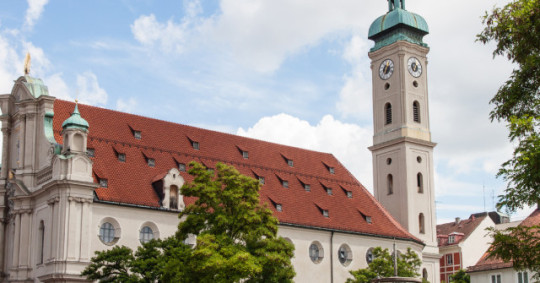
Another Catholic church in the heart of Bavaria, Heiliggeistkirche, commonly known as the Church of the Holy Spirit, is a Gothic hall basilica. The church lies on the edge of the Viktualienmarkt. It originally belongs to the Hospice of the Holy Ghost of the 14th century. Johann George Ettenhofer remodeled the landmark in 1724, and he took six years to complete the architecture. The areas of renovation were vaults and pillars. The inner side of the church features Rococo frescoes and stucco ornament by the very famous Asam brothers. Well, the original décor was awe-inspiring, but this cathedral had faced destruction during World War II. Even the interior furnishings were damaged to a great extent. However, after the war, renovations and restorations were carried out. In 1991, the interior was entirely reconstructed. If you are looking for the original landmark, you will only get the remnants of the north wall of the nave. And the tower of the church has a beautiful lantern dome. Look closely at the Neo-Baroque façade, and it is quite clear that the elements used in it are borrowed from Viscardi’s Trinity Church. Overall, the Church of Holy Spirit is worth exploring, and especially, its interior has something captivating that you can’t resist yourself from seeing it. Burgersaalkirche (Citizen’s Hall Church)

Most probably one of the smallest churches in Munich, Burgersaalkirche, known as Citizen’s Hall Church, is not less than others in terms of architecture. If you ask locals about it, you may find a mix response. Yes, this is not very famous among the Bavarian community. However, the vibrantly painted ceiling inside the basilica is magnificent. It also has a cute but contemporary style chapel on the ground floor. You need to go upstairs to discover more paintings and highlights. It’s another masterpiece by Giovanni Antonio Viscardi, and it was built between 1709 and 1710. There are two churches in one big Burgersaalkirche. The upper church is on the higher floor, while the ground church is on the lower portion. From the outside, the Citizen’s Hall Church is Baroque-style, and the statues of Madonna and Child are placed above the entrance gate. If you have plenty of time, visit the upper section of the church, too. It was once the prayer room, but it has been used as a church since 1778. I am sure you would like to view the masterpiece of decoration in the place, which is the statue of the Guardian Angel with the child. And yes, there is also a grave of Rupert Mayer on the lower floor of the church. St. Maximiliankirche (St. Maximilian Church)
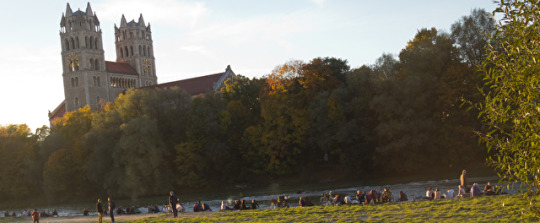
Like many others in the Bavarian capital, St. Maximiliankirche, popularly known as St. Maximilian Church, is a Roman Catholic Parish Cathedral. It beautifully nestles near the River Isar in Munich on the southern side of Germany. The church took several years to finished, and it was erected from 1892 to 1908. Heinrich von Schmidt was the designer and the mastermind behind the stunning architecture of St. Maximilian Church. He made sure to design it in the Romanesque Revival style. If I talk about myself, I couldn’t get a chance to visit this place more than once. However, the giant structure of beauty is still in my memory. The cathedral is quite massive as compared to small churches in Munich. I adore the Romanesque-style façade that plays a vital part in heightening the value of the place. When it comes to the interior, it’s modest. The walls are plain with a few paintings and murals, but the furniture and ceiling are highly decent yet elegant. Galleries Open galleries connect two towers of the building. Moreover, the soil of the place was very soft in most of the construction location. That’s why wooden beams were used for the support of the roof instead of traditional stones. Keep in mind one thing that the church was damaged a lot during World War II, and it was reconstructed in 1949. The overall appearance of the building is outstanding. So, everyone should visit this gorgeous land at least once in their lifetime. St. Lukaskirche (St. Luke’s Church)

I am sure you don’t want to skip St. Lukaskirche, as known as St. Lukas or St. Luke’s Church, which is probably the largest protestant church in the urban center of Munich. This only preserved Lutheran Parish Church is the creativity of Albert Schmidt. It was erected and completed between the time duration of 1893 and 1896, so it took three years to get the final appearance. It gracefully lies on the banks of the Isar, between the Mariannenplatz and Steinsdorfstrabe. And you can consider it among the historical places where people not only worship and perform holy rituals, but it is open for non-believers, too. Special on Architecture Nobody could ever ignore the structure of the building because of its Romanesque-style features. Albert wanted to give it a pre-reformation look, so he designed the façade of the church to rule the skyline of Roman Catholic Munich. And if you explore the interior, you will be surprised to view Gothic-style décor. However, both designs make the St. Lukas Church worth seeing. The church welcomes visitors and sightseers from all around the earth almost every day. It is also the venue for various cultural programs and concerts. When it comes to services, they held plenty of times per week. Moreover, the church community is in love with the St. Lukas gospel choir, which started in 1991. Now they have over 70 singers with flawless and melodious voices. Kreuzkirche (Holy Cross Church/All Saints Church) Not the typical one in the city, Kreuzkirche, also renowned as All Saints Church, is a cemetery church in the Bavarian capital. It is famous by the name of Holy Cross Church, too. Located in the southern end of Germany, Kreuzkirche features a sharp façade, and it is among the top-notch Catholic churches in my hometown. Jorg von Halsbach was the creator and designer of the landmark. It was erected in 1478, and consider it the first holy building with a cemetery in the Saint Peter parish. In the beginning, it was situated at the crossing of four roads. That’s why locals call it the Holy Cross Church. The building of the cathedral is in highly good condition, and all the visitors have permission to roam without hesitation. With brickwork walls in red and a giant bell tower, Kreuzkirche can be seen from a distance. Its architecture highlights the sky of Munich. When it comes to interior décor, it is in Baroque style, and the frescos are stunning to view, too. There are also few attractions within the church, so book your tour to discover them by yourself. I think I forgot to mention about the tomb of banker Gietz and the Phantom of Virgin to St. Augustine that are also there to teach mysterious old facts related to Saint. Paul’s Church

One of the large Catholic churches in Munich, St. Paul’s Church, lies in the city’s quarter of Ludwigsvorstadt-Isarvorstadt. Austrian architect Georg von Hauberrisser designed this gorgeous building, and it took almost fourteen years to complete the landmark. It was constructed between 1892 and 1906. The church was created in the Gothic Revival Style. For outer appearance, limestone from Ansbach is used to enhance the façade of the church. On the other side, upper Bavarian tuff is the primary component for the interior décor. Other than these, the core of the masonry consists of brick. When it comes to towers, the central one is 97 meters, while the two on the west are 76-meter tall. Moreover, the western exterior is decorated by a giant rose window above the entrance side of the church. The entire façade and interior look highly gorgeous. Unfortunately, during the time of World War II, St. Paul’s Church was severely damaged by air raids. It was one great destruction because the large pieces of equipment were lost, which also include the high altar. However, the church was restored with time.
Other Churches in Munich
As I have mentioned earlier, Munich has over twenty churches, but not all of them are equally famous. Here, let me share a list of some not-so-famous cathedrals to show you some more colors of the city. Though they are not as popular as Frauenkirche, St. Michael’s Church, or Trinity Church, however, they still have some great value. So, if you have discovered all the well-known basilicas and have no idea what to do in Munich, you can try these churches, too. Damenstiftskirche St. Anna Damenstiftskirche St. Anna, a chapel in the old town of the Bavarian capital, is drop-dead gorgeous in its structure. It is no doubt one of the wonders of Munich. Elector Charles Albert commissioned it in the 18th century, and a monastery in the legal form of a chapter of nuns was set up in the church. And yes, the cornerstone was laid in 1733. It was opened for the public in 1735. This beautiful chapel is the work of a famous architect, Johann Baptist Gunetzrhainer. However, the Asam brothers took responsibility for the interior décor of Damenstiftskirche St. Anna. The ceiling fresco is the most appealing thing in the church. Other includes the nave, altar, and interior ornamentation. Like many other churches and landmarks, St. Anna was also destroyed during World War II. Later, the interior was restored in the 1980s by using old photographs and images. Even though the inner side is completely renovated, but the murals are painted in classic black and white, but the charm of the place is still alive. The only negative point of this landmark is its gate that separates the visitors from the entrance and church nave. It restricts people from exploring the central area of the church, so it can be a little bit difficult for sightseers to view highlights of the church from close. Kathedrale Maria Schutz und St. Andreas The beautiful Catholic Church, Kathedrale Maria Schutz und St. Andreas, is another under-rated cathedral in southern Germany. Call it the Cathedral of the Intercession of the Mother of God and St. Andrew. Its origin is from Ukraine, and it’s the Ukrainian Greek Catholic Cathedral. The cathedral is a piece of modern architecture. The church opened for the public in 1976. Its exterior is modest and decent. The interior is lovely, like many other churches in the city. Moreover, it can be among the best indoor things to do in Munich. Klosterkirche St. Anna in Lehel The Catholic Abbey church, Klosterkirche St. Anna in Lehel, also known as Abbey St. Anna Church, is an example of a unique art. Nestled in the heart of Bavaria, it was the first-ever Rococo church of the Old Bavarian region. It shaped the development of sacred and religious architecture in the land. Johann Michael Fischer designed this beautiful masterpiece in Rococo style in 1733. The interior designers included the Asam brothers and Johann Baptist Straub. It was all started in 1727 as a gesture of thank you for the birth of the heir to the Bavarian crown, Maximilian III Joseph. The construction was completed in 1733, and it was opened for the public in the same year. I have mentioned many times that World War II destroyed plenty of monuments. Unluckily, Abbey St. Anna was among those buildings. Rebuilt in the 1960s. The façade may look plain now, but it somehow managed to appear modest and decent. Salvatorkirche (Church of the Savior) Another Gothic-style church in Munich, Salvatorkirche, popularly renowned as the Church of the Savior, is a former cemetery church of the Frauenkirche. The Greek Orthodox Christians have been performed rituals in this place since 1829. It was also the head office of the Metropolitan German region and the Exarch of Central Europe. Do you know the Greek Orthodox community called it the Transfiguration of the Savior? Initially, it was erected in the late Gothic style in the 15th century. Later, the exterior of the church was built in a Gothic-like architecture, and some Baroque pieces were removed in the restoration process. The inside of the building is fantastic, and the entire church looks captivating, even from a distance. Don’t have enough time to observe every detail of the site? No problem. It can be one of the top outdoor things in Munich. Just spend a few minutes outside the church to know the worth of its beauty. New St. John’s Church Located in Haidhausen, the district of Munich, the Parish Church of St. John the Baptist is a Roman Catholic Church. It is a masterpiece of Matthias Berger. He designed the building in the Gothic Revival style. According to historical facts, the population of the city grew swiftly in the early 19th century on both sides of River Isar. For this reason, the church of Haidhausen became too small to fit its growing gathering, so a new, larger church was constructed. Keep in mind the foundation stone for the church was laid in the 1840s. That is why it is called the New St. John’s Church. Though the construction of St. Johannas was almost completed by 1858, however, the tower took more time. It was erected by 1870, and the west tower of the church is 97-meter high. We all know what happened after World War II, and New St. John’s Church couldn’t save itself from destruction. The bombardments from world war II damaged many portions of the building. After the war, restoration works repaired the building. Even the tower received a new spire, too. Wies Church The UNESCO World Heritage Site, Wies Church, is among the traditional pilgrimage churches near the city of Munich. Dominikus Zimmerman ordered to construct this gorgeous landmark between 1746 and 1754. No doubt, Wies Church is one of the purest and holiest creations of Bavarian rococo. Its decent exterior looks super-classy, and the interior snatches the attention of everyone. Add this place to enjoy historical architecture. To put it briefly, I want to say visiting cathedrals and getting information about them is one of the best things to do in Munich. From the Cathedral Church of Our Lady to Theatiner Church to St. Peter’s to every gorgeous church in the city, the highlights will not let you think you have wasted your time or something. Not even for a second. And yes, don’t hesitate to try new things. Every adventure gives us unlimited experiences. So, are you ready to unlock new chapters of thriller activities in the heart of Bavaria? Read the full article
0 notes
Text
Reflections on "La Ecosistema Yellowstone Mayor" From the Remote Office
¡Buenas tardes, desde España!
I am writing to you as I look out the window at a fishing vessel exit the Bay of Santander (La Bahía de Santander), surfers trying to catch the last of a dying swell, and families appreciating their holidays on the soft white sands of northern Spain. But just yesterday, I took my sister’s dog for a swim to San Juan de la Canal, our local beach a five minutes walk from my grandparent’s house, and for the first time in my 40 years, I caught myself wondering if I was exposing myself and my dog to something harmful. For many Bozemanites, this would be the same as considering the water quality health hazards of tubing down the Madison River in the summertime.
As a resident of the Greater Yellowstone Ecosystem (GYE), like many others, I come from somewhere else. However, my story may be a little outside the norm as my family hails from Cantabria, a province on the northern coast of Spain. Cantabria is in what is often referred to as “green Spain” due to its climate being dominated by the Atlantic coast. I am lucky to call both the GYE and Cantabria home, giving me a unique perspective.
There are some major differences between Cantabria and the GYE, most notable the presence of an extensive Atlantic ocean coastline. The GYE, considered one of the largest nearly intact temperate zone ecosystems on Earth, is sized between 18,750– 34,375 square miles with a resident population of approximately 355,000 people. Cantabria by comparison, is a magnitude smaller at 2,028 square miles with a population of 572,824. These statistics lead you to believe that there are few, if any similarities among these two regions an ocean apart. However, with a keen eye, similarities begin to emerge. Cantabria includes two mountain ranges known for its wildscapes, rock climbing, hiking, and skiing opportunities. Along with its rocky coast often referred to as “La Costa Quebrada”, these physical characteristics make Cantabria a recreational haven with biking, surfing, and sailing being the top sports. Large predators are found in the mountains such as wolves and the Cantabrian bear (el Oso Pardo), both of which present conservation conflicts with local ranchers, along with an amazing suite of raptors and the Urogallo (Tetrao urogallus), in the same family as the Sage Grouse (Phasianidae) and undergoing similar population declines and conservation threats. Cantabria is also a mecca for migrating coastal birds that find intact stop-over habitats in the wetlands and estuaries. So, when you look a bit closer, despite differences in language, culture and the proliferation of or lack of amazingly fresh seafood, Cantabria and the GYE appeal to a similar type of person, wildlife enthusiasts and recreational opportunists.
Both Cantabria and the GYE see an influx of tourists during the summer months, and with this increase in people comes economic growth as well as litter, cars, noise and crowds on trails and waters that normally see little traffic during the rest of the year. If you are like me, you might opt to stay away from the crowds, but it makes me grateful to know that these places that I all home are once-in-a-lifetime destinations for many people and children who might not have other opportunities to experience wildlife and nature so intimately. An opportunity that I think is imperative for us all.
However, there are costs involved with this influx of people. Costs, which for the record, I believe can be minimized and maybe even avoided entirely with education and responsible habits. In the GYE, we are so incredibly lucky to have high quality drinking water and air due to our intact ecosystem that functions as mother nature intended. However, we are not immune, and I have witnessed more and more invasive plants creeping on our waterways and roads, beer cans and bottles at the peaks of our mountains, fishing lines and accidentally - or purposefully - discarded trash at our campsites, in our lakes and in our rivers. At the moment, these things seem less than the norm and singular events. However, with the rapid expanse of Bozeman and the surrounding areas, what once seemed insignificant problems will become large-scale issues.
Cantabria has a human archaeological history stretching as far back as the Lower Paleolithic (3.3 million to 300,000 years ago) compared to the GYE whose human history dates back to sometime after the end of the ice age between 14,000-11,000 years ago. So, it follows that Cantabria has been dealing with human-caused environmental issues since before human settlements in the GYE existed. That being said, in my own lifetime, I have witnessed changes on the beaches and coastal areas of Cantabria that I consider my childhood playgrounds. There are two things that have struck me the most on my current visit in Cantabria. Water quality issues and a changing climate.
Ok, so back to why I was concerned about taking a dip in the ocean yesterday. The previous day’s headlines had alerted us to how swimmers at the local beach had suffered skin reactions to the water and this led to a temporary closure of the waters. For me, it was a clear and very sad moment when for the first time in my life, I was questioning the health of taking a dip in the ocean rather than ranting about its benefits. This in itself is disconcerting, but the truly scary thing here is days after water samples were analyzed, the public has yet to be told a clear story of what caused the reactions with officials vaguely citing the presence of microorganisms.
The connection here to the GYE stems from the issues that result from a rapidly increasing population and extensive land use change. On the beaches of my mother’s hometown, there were no sewage treatments when I was a child and this waste was discarded directly into mother ocean. This may seem outrageous, but for small pueblos where septic tanks, cow’s milk, outdoor showers, and lack of heating/cooling are the norm, large-scale sewage treatments were not needed. However, as the adjacent city of Santander expands towards these pueblos, and more people move to the country to enjoy the space and country living that pueblos offer, sewage treatment plants have been installed. Despite this seemingly positive change, today’s problem is that the sewage plants can’t keep up with the need of an increasing population, especially during the summer swell. It’s not just lack of infrastructure at play here, but also mismanagement and corruption. This rings a bell for me as a GYE resident. As the population of Bozeman continues to grow at an alarming rate and more and more of Gallatin Valley is converted from ranch or native grasslands to semi-urban and suburban areas with paved roads and manicured gardens, we will also face the impacts of rapid land use change. Maybe we will find ourselves with overflowing or inadequate sewage and stormwater treatment. We could just build more and better treatment systems, but what are the costs involved - both financial and ecological?
Changes in climate and new normals have come up in conversation a few times now during my trip. On a skeptical but positive note, a local friend of mine who has spent his whole life in Cantabria and has one of the best gardens I have ever seen, commented on how the warmer and longer summers and more temperate winters in Cantabria have made it possible to grow avocados and other sub-tropical fruits that my own grandmother would not have thought possible. To me, that is one of the clearest signs of climate change possible! On a more melodramatic note, I am noticing the proliferation of trash on the beaches and in the ocean waters much more on this visit then ever before. It has actually made me stop and consider whether or not I wanted to take a dip in the ocean. At first, I thought I was being spoiled coming from the GYE where we rarely (but increasingly) see large amounts of litter. But, after further thought, I have landed on a hypothesis that is more tied to changing ocean tides due to warming waters than an increase of littering culture. Climate change is changing everything in our world, from the smallest micro-organism to the largest mountain in ways that we may never fully understand. And, this may seem too overwhelming to many of us, but when we break it down into smaller changes that we can each make in our own lives, it becomes much more manageable. The simplest change I would suggest is completing cutting out plastic water bottles, one time use coffee cups, and other disposable items from your life. Sometimes, I like to remember my grandmother and what she would have done to have drinking water, groceries and coffee in her house. She would have filled a glass jug with water from the local spring or well, collected her groceries from the market in a cloth bag and served her guests coffee in ceramic mugs - often the simplest way is the best way.
Sometimes, as a resident of the GYE it is easy to forget just how special our backyard is as one of the last intact ecosystems. This might be what strikes me the most when I travel across the world to my homeland in Cantabria, a region that has a human history stretching 1000’s of years times that of the GYE. It seems to me that we, as residents of the GYE, are beyond lucky to reap the benefits of a functioning ecosystem. In my opinion, we have it easy as the great expanse of our public lands and our lack of concentrated urban areas lets us easily avoid the problems faced across the globe in regions of high populations. It is so easy for us to lose perspective. I complain when I find shards of glass at the top of Livingston peak, or if I have to scoop up a lost beer can on the Yellowstone River, but these are singular incidents for NOW. We have the opportunity to keep these problems manageable and even find solutions that work for everyone. The gift we have as residents of the GYE comes with an extremely affordable price, that of being stewards and students of history. It is our responsibility to look toward other regions that have already experienced the impacts of population growth and who are already innovating solutions that include humans in their ecosystems, rather than separating us from our wild heritages. We are a young community in the GYE and we need to look towards our sisters for guidance. If we fail to maintain the health, beauty and function of our GYE ecosystem, how can we hope for change across the world?
Mikaela Howie is YERC’s assistant lab manager
1 note
·
View note
Text
Trip I: Exploring Chinatown!
This past Friday, September 6th, a group of friends and I from my Global Chicago class had the opportunity to venture to Chicago’s Chinatown! While I had been a regular visitor to the area’s popular restaurants and bakeries, my previous experiences in Chinatown were extremely limited; this gave me all the more reason to look forward to exploring the area’s rich cultural history, architecture, and overall lively community. For this trip, our group of 3 constructed a small itinerary, keeping in mind to explore Chinatown’s rich history, as it is notably among Chicago’s most culturally authentic neighborhoods, and differs significantly to other Chinatowns; Chicago’s continues to grow as its community continues to preserve cultural values and traditions (Ecker, 2019). With these thoughts in mind, we set off.

Welcome to Chinatown Map. This is the map that is shown in various areas of Chinatown, this one specifically found close to the nearby Redline exit, readily available for new or returning visitors. Most notably, the sign appears in both English and Traditional Chinese. This foreshadows a common theme observed later in the trip. | Original photo
As my group members and I began our adventure to Chinatown, we decided to take the LaSalle and 33rd street bus, as we noticed the bus route took us directly through 2200-2500 S Wentworth Avenue, leading us right to Chinatown’s many shops and businesses. We exited the bus right in front of the Chinatown gate, and what instantly caught my attention was the abundance of people, walking, conversing, getting into vehicles, or selling goods, occupying the streets. To be completely honest, I had only been to Chinatown a handful of times, most of them being late-night food runs with friends, but this experience was very different! Going to Chinatown at night, most of the people I typically saw had been tourists, doing the same as me; simply there for food or something quick. Contrasted to what I was seeing then, Chinatown during the day was illuminated by the areas shopkeepers, workers, and everyday people living in the area. (As you can see in some of these photos, I was trying really hard not to accidentally photograph anyone, people were everywhere!)
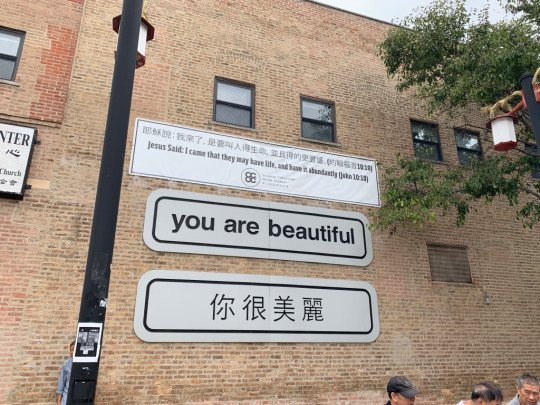
You are beautiful sign. This was the first thing that stuck out to me as I exited the bus. A very pleasant welcoming, accompanied by the area's abundance in people, as seen in the bottom corner of the photo. | Original photo
Making our way further down the commercial street, I noticed the wide range in products being sold by various vendors, with overall themes of gift shops, cosmetic stores, beauty salons, restaurants, markets, houseware stores, the list seemed to go on and on. From medications to souvenirs, the street was filled with fast paces customers and what appeared to be lots of family-owned/independent businesses. The shops are well acquainted with their clientele, as I noticed many advertisements and signage were both in native languages, specifically Traditional Chinese, and English as well. Although my group and I didn’t get the chance to step foot into these shops, we still felt well accommodated and welcomed; generally, I was filled with excitement and lots of curiosity walking down this street.

Herb shop among many others on the commercial street. While in-store photography was prohibited, the outside storefront was the closest I could get to photographing the ginseng. Notably interesting way of storing/selling the herbs. | Original photo
Specifically, one thing I was eager to see being sold in these shops was ginseng, after my professor had mentioned the product’s popularity and abundance in the area. Ginseng is very popularly sold in Chinatown and is known for its ability to act as “an adaptogen, balancing bodily functions” (Chinatownreport, 2018). To my surprise, however, every ginseng carrying shop we attempted to explore had large signs showing that store photography was strictly prohibited. It made us question the overall reasoning behind this; is ginseng really that popular of a commodity? Is it rare? I may never know, but respect the potential of cultural significance being the reason behind its mild secrecy.

Herbs in storage up close. The size and presentation were very interesting to me; I had never seen herbs like this before in my hometown. | Original photo
Before exiting commercial street, the Pui Tak Center was the next stop on our list. Off first glance, I was able to note the building greatly contrasted with the street’s abundance in shops. Although I wasn’t able to enter the building out of the sake of time, allow me to paint you a picture (before showing you actual photos) in an attempt for you to understand the state of awe I was in upon first glance. Exterior wise, the building was significantly taller than its neighboring shops, characterized by all-brick walls and detailing colors of red, teal, navy blue, and tan. Standing outside of the building, I noticed the architecture was unique, including traditional roofing and accents, and many pillars. Being surrounded by sounds and sights of busy customers, workers, and general people, the Pui Tak center serves as a “church-based community center” that provides the Chicago Chinatown and surrounding communities with programs concerning adult education, youths/children, music, technology, and immigration services (puitak.org).

The Pui Tak Center, front-facing/left corner view. | Original photo
The next landmark our group went to view was the Nine Dragon Wall. This wall is the first piece of art seen by visitors when exiting the red line station, and most evidently the first large piece of art we saw after passing through the commercial street of Wentworth Avenue. The wall itself was modeled after the original Nine Dragon Wall constructed in 18th century Beijing, and is actually one of the only three existing replicas made outside of China (chicagochinatown.org). The Chicago Nine Dragon Wall is characterized by 9 dragons in the center, including the colors red, gold, and blue; in traditional Chinese culture, dragons are chosen to represent a mascot of powerful status, while the 3 colors are chosen to represent focus and good fortune. Symbolically, the number 9 is chosen to signify yang, as Ancient Chinese texts “categorized numbers into yang numbers and yin numbers”, yin and yang serving as a symbol for balance and 9 being the highest and largest yang (Oakes, 2017). Seeing the wall up close was comparable to viewing a work of art in a museum. The vibrancy of the colors and the details in the dragons is refreshing to see anytime I take the Redline to Chinatown, I can’t help but marvel in its beauty; I haven’t seen anything similar to it before. Learning the history behind the wall makes me want to visit it once more, now knowing that every component is symbolic to the areas of cultural origins.

The Nine Dragon Wall. | Original Photo
One of the final landmarks on our list was the Ping Tom Memorial Park, a historic park that was originally created around 1999 to memorialize and honor Ping Tom, the most notable civic leader in Chicago’s Chinatown (chicagochinatown.org). Specific components of the park including the large orange plaza, the river, the playground, and the memorial area all provide a calming and therapeutic space, essential for community members to come to the park and reflect on the area’s cultural history. During my time at the park, I had felt extremely relaxed and calm. The park had a nostalgic touch, reminding me of parks in my own hometown. With the various aspects of nature along with the city in a clear view, it’s hard for one not to reflect on your environment and just generally speaking. This was my favorite thing we visited, and am planning to return soon.
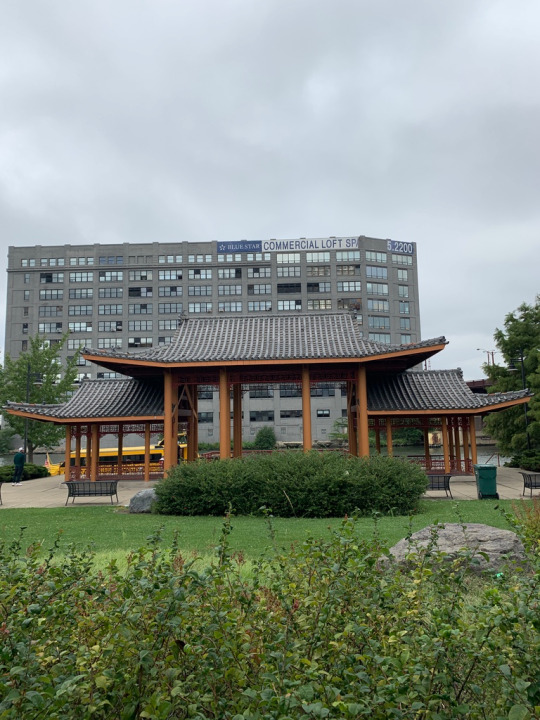
Ping Tom Memorial Park. The large plaza is the first thing that can be seen when first arriving. | Original photo

Memorial statue of Ping Tom, explaining the park’s significance to the community. | Original photo
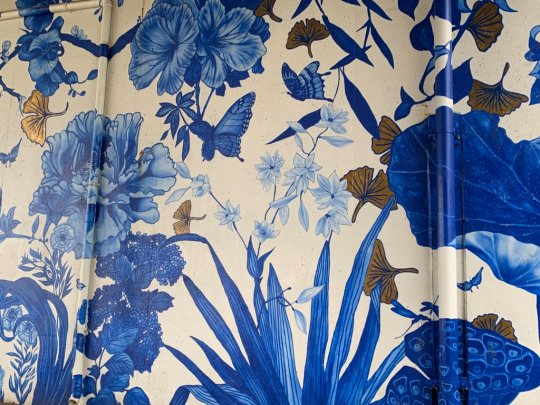
A mural located under the bridge of Ping Tom Memorial Park. The cool blue tones of the mural add to the calming and reflective environment, and images of butterflies and flowers allude to the importance of nature and roots. | Original photo
To end our trip, my group and I decided to get lunch, leading to us venturing to Joy Yee Noodles, a popular restaurant known for their noodle cuisines and bubble tea. We decided to order two larger style dishes and share between the three of us. (Additionally, before you continue on to my food experience, I would say if you haven’t eaten here before, or it’s your first time dining in Chinatown, I solidly recommend Joy Yee! The staff was incredibly accommodating and their menus provided a wide range of fan favorites for first-time customers!)
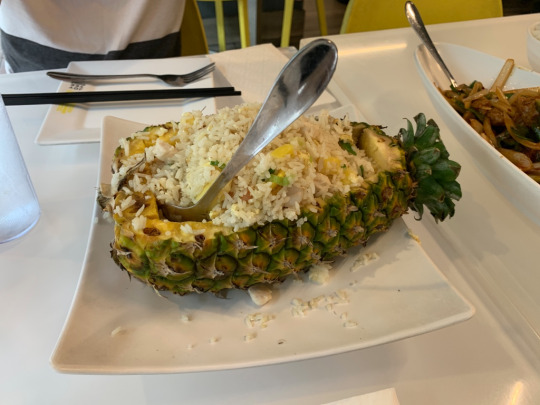
Special fried rice dish, ordered to share between our travel group. Delicious and plentiful. Couldn’t get over the creativity in the dish’s presentation. | Original photo
Even as a frequent Chinatown food-enthusiast, I have to say this rice definitely topped any rice dish I had tasted in the past. (Served out of a pineapple skin as well! Wow.) I had never had a dish like this, and I thought the “pineapple bowl” was an extremely unique conversation starter, and easy to share with friends as well.
Before heading out and venturing back home, I made it a goal of mine to order bubble tea as well. I ordered a lychee-strawberry smoothie with tapioca pearls, which was refreshing and new to me as well! Having only ever tried milk-based tapioca tea before, this fruit-based drink introduced my tastebuds to something I’m excited to try again in the future.
Boba rating: 5/5 starts | Cuisine rating: 6/5 stars (Extra credit for the pineapple bowl. Very innovative.)
Overall lunch break verdict: fair prices, decent portion size, and overall a very refreshing way to end my trip.

Ultimately, this trip to Chinatown was very eye-opening to the rich cultural history and experience the area has to offer outside of just its food restaurants. It excites me that Chicago’s Chinatown continues to grow, and has avoided the effects of gentrification because of the community’s morale and their general sense of belonging to the area (Eltagouri, 2016). Although this is my first documented trip in Chicago, I definitely had a moment during this trip where I realized how much I had been missing out on; the scenery, the architecture, the symbolism, the community, the lively people, the culture, all just one bus ride away from me. This trip excites me for the next to come and encourages me to get out of my comfort zone more often, to explore what the city has to offer.

City skyline view from Ping Tom Memorial Park. The park’s natural foliage contrasts the city skyline, a factor I thought contributed to the location’s beauty and overall balance between city view and nature. | Original photo
Sources:
(2018, October 9). THE BEST HERBS TO BUY IN CHINATOWN. Retrieved from http://chinatownreport.com/best-herbs-to-buy-in-chinatown/
District, C. P. (n.d.). TIP on Tour Finalist Party at Ping Tom. Retrieved from https://www.chicagoparkdistrict.com/parks-facilities/tom-ping-memorial-park
Ecker, D. (2019, May 10). The battle for Chinatown's future. Crain's Chicago Business.
Eltagouri, M. (2016, May 13). Here's why Chicago's Chinatown is booming, even as others across the U.S. fade. Chicago Tribune.
Our Building. (n.d.). Retrieved from https://www.puitak.org/about/building
The Meaning Behind the Nine-Dragon Wall in Beijing's Forbidden City. (2017, October 15). Retrieved from http://www.visiontimes.com/2017/06/23/the-meaning-behind-the-nine-dragon-wall-in-beijings-forbidden-city.html
Resources – Landmarks & Tourism. (2015, July 24). Retrieved from https://chicagochinatown.org/resources-landmarks-tourism/
0 notes
Text
I was torn between Spain and Portugal and even did a small poll on social media to help me make a decision. It was eventually all the amazing travel photos I saw and articles I had read on Portugal that persuaded me to choose this beautiful destination in the Mediterranean.
Lisbon
I actually fell quite ill from my last days in France, so I actually needed a lot of rest. I took a day off to rest so I could enjoy my holiday, it was pointless forcing it.


I loved Lisbon and wish I had had time to explore more of its vibrant neighbourhoods. Colourful Portuguese-styled Prombaline and Rococo buildings line the bustling narrow roads and corners with some displaying beautiful tiled patterns.

I stayed in the main tourist area of Barrio Alto during July. These streets are busy whole day and night. The evenings are filled with music from the tightly packed bars and people spilling into the streets enjoying the warm summer nights. It’s a buzz.

Belem
One of the first tourist sites to visit in Lisbon was the Fortress of Belem. I took a train to Belem and walked along the harbour to the fort. You’ll first come across the Monument of Discoveries depicting the golden era of Portugal’s discoveries across the world.


The tower of Belem was originally situated on the Tagus River located near the shore on a small island. The extended shoreline has made the tower closer to the mainland. It’s a cool place to chill near the beach with some people dipping their feet in the icy Atlantic waters around it. There’s also a park to make a picnic and chill out on across from it.

Caiscais the Beach Day
What’s a summer holiday without a beach day?
View this post on Instagram
The last day was beach day. If you visit Lisbon in summer and join the locals at the beach in Cascais. 🇵🇹 🏖 🌞 . . . I wouldn’t have known about this spot if my business school director did not tell me about it. Over our lunch in Paris she said it’s a must see. This town had the ultimate Mediterranean vibe. . . . . . . . #beedujour #journeysofgirls #luxetravelbelle #visitportugal #cascaisportugal #cascais #cascaislovers #igersportugal
A post shared by Bee | CT Lifestyle Blogger (@beedujour) on Jul 7, 2019 at 12:38pm PDT
Caiscas was suggested to me as the best and closest beach to unwind and escape from the bustle of Lisbon. The little town was the just exudes that Mediterranean getaway feel by the sea. Many yachts are moored in the bay with water slides erected in the middle of the bay for kids to enjoy.
My Week in Portugal
I travelled to Portugal in early July and the weather in Lisbon was refreshing cool and humid. I found this to be such a relief especially after spending a week in a heatwave in the South of France. I honestly fell in love with Lisbon. A beautiful cosmopolitan and creative city surrounded by natural beauty near the ocean ticks off all my essentials. It sounds a lot like my own hometown of Cape Town doesn’t it?


While I don’t have any plans to return soon, I do hope to explore the North and Southern regions of the country and maybe go wine tasting. Their Verde white wine was definitely one for the books!
Safe Travels
Bee
Visiting Portugal: Lisbon I was torn between Spain and Portugal and even did a small poll on social media to help me make a decision.
1 note
·
View note
Photo

This post contains affiliate links. I will earn a small commission when you use my links to make a purchase, at NO extra cost for you.
Lapland in winter is a magical wonderland. Whether you’re after adventure or fun in the snow, here’s a list of fun things to do in Lapland.
Extending for hundreds of miles above the Arctic Circle, Lapland is one of the last remaining wildernesses in Europe. For many, this northern extreme is a mystery – where the midnight sun shines endlessly in summer and the stunning Northern Lights dance in the sky during the long, polar winter nights.
Our month-long trip in Lapland was one of the most memorable trips of my life. We crisscrossed the region by train, in search of the Northern Lights and winter thrills. And we found whimsical villages, spectacular winter landscapes and plenty of fun in the snow. It felt like a real-life Narnia, where fantasies came true.
But Lapland is more than just Santa Claus and Northern Lights. There’s so much to do here for thrill seekers: from dog sledding to snowmobiling and snowshoeing. You can choose to do as many winter activities as you want, or just spend your time relaxing in a naked sauna and an ice hotel.
Lapland is truly out of this world and you have to see it for yourself to believe it. It’s definitely one of the best winter destinations in Europe and highly worth a visit! This is a Lapland travel guide for those who are planning a winter trip to this beautiful part of the world.
Things to Do in Lapland
Where to Go in Lapland?
The vast and rugged region of Lapland is the region of northern Europe that lies within the Arctic Circle. It stretches across northern Norway, Sweden, and Finland and into the Kola Peninsula of Russia.
Since Lapland covers such a wide area, most people choose to base themselves in just one part of Lapland, then explore and do winter activities from there. To help you decide on which part of Lapland to visit, here is a breakdown of each part of Lapland:
Finland
The Finnish Lapland is the most visited part and also the cheapest and most accessible area. Rovaniemi is the capital of Finnish Lapland, and the hometown of Santa Claus. There are loads of modern hotels here, as well as winter activities to do, and still within easy reach of more remote and rugged areas.
Kemi is another popular spot in the Finnish Lapland. It’s home to two of Finland’s blockbuster winter attractions – a snow castle and an ice-breaker cruise.The remote village of Kilpisjärvi is suitable for those looking to venture deep into the wilderness. The northernmost settlement in the ‘arm’ of Finland is wedged between the lake of Kilpisjärvi and the magnificent surrounding fells. It is also the highest village in Finland.
Sweden
The Swedish Lapland has earned a reputation for itself with the original Ice Hotel and it’s still easily accessible from the capital Stockholm. Kiruna is the Swedish Lapland’s biggest city, and the best place to come for anything beyond basics like food and petrol.
For most people, Abisko is the highlight of a visit to Swedish Lapland. The town is one of the best places on Earth to see the northern lights. Don’t miss the Aurora Sky Station, which is accessible by ski lifts, and you can even have a nice dinner up there. Of all the major towns in the Swedish Lapland, Jokkmokk is probably the prettiest. It’s also the centre of Sami culture in Sweden, and has an excellent Sami museum and Sami market. Another popular place to visit is Jukkasjärvi, home to the Ice Hotel.
Norway
The Norwegian Lapland, also known as Finnmark, is definitely the most expensive area to visit, but it can be easily combined with the rest of the country. Norway is what I consider the most beautiful country in Europe and there are plenty of see, regardless of the season.
Alta is the biggest town in the Norwegian Lapland, and is one of the best places to see the Northern Lights in Norway. Fish in the Altaelva river, explore Northern Europe’s largest canyon, or see world famous rock carvings at the Alta Museum. Kirkenes is another great base for those who want to explore the Norwegian Lapland. Only 15 kilometres from the border with Russia, Kirkenes feels like a real frontier town. Plus it’s in prime Aurora territory.
Narvik’s ski resort Narvikfjellet offers some of the best extreme and alpine skiing in Norway. It has one of Scandinavia’s largest drop heights and offers excellent conditions for off-piste skiing. We did an outdoor obstacle course at Narvikfjellet and highly recommend it!
How to Get there
This of course depends on which part of Lapland you’re planning to visit. It is now affordable and easy to book flights to many parts of Lapland from main hubs in Europe. Here’s a breakdown:
Finland
The gateway to the Finnish Lapland is the Rovaniemi Airport. Easyjet and Norwegian fly direct from London Gatwick to Rovaniemi in winter and spring. You can also catch a domestic flight from Helsinki to Rovaniemi on Finnair or Norwegian. The flight takes 1.5 hours and cost around 70euros return if you book in advance.
There’s also a Lapland Express train that goes from Helsinki to Rovaniemi in 8 hours. It’s a sleeper train with comfortable sleeping berths. There are also airports in Ivalo, Kemi and Kittilä.
Book Your Flights to Rovaniemi
Sweden
The biggest airports in the Swedish Lapland are in Kiruna and Lulea. Norwegian and SAS fly from London to Kiruna for around 200 euros return. Both airlines also fly from Stockholm Arlanda to Kiruna for around 100 euros return and Lulea for 80 euros return.
There’s also a sleeper train that goes from Stockholm to Kiruna in 18 hours. It costs around 50 euros each way. You can easily catch a train from Kiruna to Abisko, Jokmokk and other parts of the Swedish Lapland.Read the next section for info on train travel.
Book Your Flights to Kiruna
Norway
The main entry to Norwegian Lapland is from Alta Airport. Norwegian and SAS fly from London to Alta for around 250 euros return. domestic flight to Alta. A domestic flight from Oslo to Alta costs around 180 euros return and take around 2 hours. Flights to Narvik take 1.5 hours and cost the same. There are no trains connecting one town to another in the Norwegian Lapland — it’s best to rent a car.
Book Your Flights to Alta
How to Get Around Lapland
The best way to get around Lapland is by train as that’s the most feasible mode of transport when there are severe winter conditions. We traveled all over Lapland via a combination of train and bus, and had no problem (besides one occasion when we had to wait for a connecting train in the freezing cold, at a station with no indoor waiting area).
The Arctic Circle Train is the most scenic rail journey in Lapland. The route goes from Kiruna (Sweden) to Narvik (Norway), with stops at Abisko, Björkliden and Riksgränsen. Known as one of the greatest rail journeys in the world, the Arctic Circle train brings travelers along stunning fjords, near frozen glaciers, under icy waterfalls and whisk you past fairytale towns. It offers stunning scenery of Lapland and lets you see many of the rural parts of Scandinavia that are not accessible by cars.
GoEuro is an excellent search engine that lets you find out how to get from one town to another via train, bus or plane.
To find out train prices and schedules, you’ll need to check the website of each country’s train company:
Finland — www.vr.fi
Sweden — www.sj.se
Norway — www.nsb.no
Here are some details of travel time between the major towns and cities of Lapland:
Finland
Helsinki — Rovaniemi: 8 hours | Cost 80 euros each way (train)
Helsinki — Ivalo: 11 hours | 130 euros each way (train)
Rovaniemi — Kemi: 1.5 hours | Cost 15 euros each way (train)
Rovaniemi — Kittilä: 2 hours | Cost 19 euros each way (bus)
Rovaniemi — Ivalo: 4 hours | Cost 35 euros each way (bus)
Sweden
Stockholm — Kiruna: 18 hours | Cost 50 euros each way
Kiruna — Jukkasjärvi: 0.5 hours | Cost 4 euros each way
Kiruna — Abisko: 1 hour | Cost 7 euros each way
Kiruna — Jokmokk: 4 hours | Cost 28 euros each way
Norway
Kiruna — Narvik: 2.5 hours | Cost 13 euros each way (train)
Narvik — Stockholm: 21 hours | Cost 68 euros each way (train)
Narvik — Alta: 7 hours (car)
Narvik — Kirkenes: 5.5 hours (car)
When to Travel Lapland
Undoubtedly January-March is the best time to travel Lapland. They bring long dark nights and plenty of snow to play in during the day to keep you entertained. But it can be very, very cold indeed, with temperatures going from -10°C to +5°C (14 to 41 F). And there are only 4-6 hours of good daylight each day! It can get pretty crowded in December, as people flock here for short Christmas trips.
The spring equinox (around 20 March) brings greater solar activity. Combine this with slightly warmer temperatures and improving weather (with the possibility of less cloud cover) and this is the best time for aurora hunting.
September and October enjoy neither the summer warmth nor the winter snow. This is not the best time to visit Lapland – many tours and attractions are closed. However, photographers may like the autumn colors, and the Northern Lights could possibly make their dramatic appearance, especially around the autumn equinox.
Travel Independently or With a Tour?
The whole region is easy to navigate and explore independently, however you’ll be limited to bigger towns that have train stations. Buses don’t run frequently in winter due to thick snow, and renting a car is only recommended if you have experience driving in snow (we’ve driven in many countries, but we still got stuck in snow one time and that was pretty scary).
If you’re interested in booking an all-encompassing winter tour, check out Artisan Travel. They have over 16 years of experience running winter tours in Lapland and is one of the most reputed operator in the region. They have some great 4-day trips in Sweden and Norway and 8-day Finland active winter tour that include flights, meals and all kinds of winter activities.
You can also book day trips, but these are quite limited. The easiest place to book day trips from is Rovanimi, Finland. Choose from snowmobile safari to visiting Santa Claus village or an ice floating experience.
Things to Do in Lapland
1. See the Northern Lights
Lapland is one of the best places in the world to see the Northern Lights. Due to the nature of the earth’s magnetic field, the auroras only appear at the poles. Lapland, which sits at the latitude of approximately 68° north, is thus in an ideal location for seeing the Northern Lights.
Solar activity can be unpredictable though. Out of the month we were in Lapland, we only saw the lights for three nights. Don’t hold high expectations and you should be fine.
For higher chances of seeing the Northern Lights, I recommend booking a Northern Lights tour. After all, these tour operators have been chasing the Northern Lights for years and know the best spots for them. Alternatively, stay in a Northern Lights hotel, such as the Aurora Dome to get the chance to see the lights right from your bed.
Check the Aurora forecast or download the Aurora Forecast app on your iPhone to monitor. Usually the best time of night (on clear nights) to watch for auroral displays is local midnight (adjust for differences caused by daylight savings time).
.IRPP_kangoo , .IRPP_kangoo .postImageUrl , .IRPP_kangoo .imgUrl , .IRPP_kangoo .centered-text-area { min-height: 100px; position: relative; } .IRPP_kangoo , .IRPP_kangoo:hover , .IRPP_kangoo:visited , .IRPP_kangoo:active { border:0!important; } .IRPP_kangoo { display: block; transition: background-color 250ms; webkit-transition: background-color 250ms; width: 100%; opacity: 0.99; transition: opacity 250ms; webkit-transition: opacity 250ms; background-color: } .IRPP_kangoo:active , .IRPP_kangoo:hover { opacity: 1; transition: opacity 250ms; webkit-transition: opacity 250ms; background-color: } .IRPP_kangoo .postImageUrl , .IRPP_kangoo .imgUrl { background-position: center; background-size: cover; float: left; margin: 0; padding: 0; } .IRPP_kangoo .postImageUrl { width: 30%; } .IRPP_kangoo .imgUrl { width: 100%; } .IRPP_kangoo .centered-text-area { float: right; width: 70%; padding:0; margin:0; } .IRPP_kangoo .centered-text { display: table; height: 100px; left: 0; top: 0; padding:0; margin:0; } .IRPP_kangoo .IRPP_kangoo-content { display: table-cell; margin: 0; padding: 0 10px 0 10px; position: relative; vertical-align: middle; width: 100%; } .IRPP_kangoo .ctaText { border-bottom: 0 solid color: font-size: 13px; font-weight: bold; letter-spacing: .125em; margin: 0; padding: 0; text-decoration: underline; } .IRPP_kangoo .postTitle { color: font-size: 16px; font-weight: 600; margin: 0; padding: 0; } .IRPP_kangoo .ctaButton { background-color: margin-left: 10px; position: absolute; right: 0; top: 0; } .IRPP_kangoo:hover .imgUrl { -webkit-transform: scale(1.2); -moz-transform: scale(1.2); -o-transform: scale(1.2); -ms-transform: scale(1.2); transform: scale(1.2); } .IRPP_kangoo .imgUrl { -webkit-transition: -webkit-transform 0.4s ease-in-out; -moz-transition: -moz-transform 0.4s ease-in-out; -o-transition: -o-transform 0.4s ease-in-out; -ms-transition: -ms-transform 0.4s ease-in-out; transition: transform 0.4s ease-in-out; } .IRPP_kangoo:after { content: ""; display: block; clear: both; }
READ NOW
Northern Lights in Iceland: A Guide on Where and How to Find them
2. Stay at the Ice Hotel
Amidst the gorgeous Narnia landscape of the Swedish Lapland stands Ice Hotel, the world’s first hotel built entirely of ice and snow.
Each winter, the hotel is built afresh in Jukkasjärvi, right next to Tornio River where the ice is collected from. Over 21,500 tonnes of snice (a mixture of snow and ice) are used to build the 5,500-square-meter building. Once summer approaches, the ice all melts away and flows back into the river. To avoid pollution, the hotel never uses color or paint in the ice.
Around 45 artists from around the world are invited to design the suites each year. Each suite features its own unique design and story so before you book your stay at Icehotel be sure to find the story behind your suite. Read my post about it here.
If the high prices of the Ice Hotel or the prospect of sleeping on ice scare you, you can still come for a day trip. Alternatively, check out the Snowman World in Rovaniemi, a similar hotel made of snow and ice. It’s just as big and has a dozen themed rooms as well as an ice bar and restaurant.
3. Go Snowmobiling
In Lapland, snowmobiling is a way of getting from one place to another (instead of cars). You can easily rent a snowmobile for the day or even do multi-day snowmobile safari, crossing ice lakes and vast wilderness.
It’s pretty easy to drive the snowmobiles, and they’re quite stable as well. We drove snowmobiles in Rovaniemi, Abisko and Narvik. We did skid on a frozen lake and almost spinned out of control, but nothing serious happened.
Keep in mind that snowmobiles can go up to 120 km/hour and is not simply a toy to mess around with. A driver’s license is required and just like driving a normal vehicle, no drinking is allowed before taking the wheel.
4. Go Dogsledding with Huskies
Dog sledding in Lapland is super fun for both adults and kids alike. You’ll be riding on sleds that are drawn by husky dogs. As a dog lover, I had my doubts about dog sledding prior to this trip. All sorts of questions filled my mind: Are the dogs being treated right? Is this animal abuse? But once I met the huskies, it was obvious that I had nothing to worry.
Huskies live to run. Every day they run for miles, not just as a race with their peers but also for the fun of it. They have so much energy wound up within them that running is the best way for them to release it.
5. Take a Reindeer Caravan
Lapland is home to the Lapp or the Sami people, who have sparsely inhabited the region for several thousand years. The Sami are the only indigenous people of the European Union, and their endangered language and culture is now protected by the various governments.
Today, the majority of the Sami people still make a living from reindeer herding and many of them run reindeer farms that are opened to tourists. You can easily sign up for a reindeer safari and spend some time with the reindeers. This way, you’ll also get to learn more about the Sami people.
6. Try Ice Fishing in the Frozen Lakes
Ice fishing is a popular winter activity in Lapland for both locals and tourists alike. We tried our hand at ice fishing on the frozen Karhulampi (Bear Lake) just outside Rovaniemi in the Finnish Lapland and it was CRAZY fun! I never thought I would enjoy fishing, but I really had a ball waiting for my bait to be caught.
The lake freezes each year from October to March, and pods of salmon and rainbow trout live in this lake all year round. It is common to find locals ice fishing on weekends with an open fire and drinking vodka.
7. Float in the Frozen Sea
This is definitely one of those once-in-a-lifetime experiences that adventure seekers would absolutely love. In Kemi, you can hop on the icebreaker Sampo on a cruise through the frozen Gulf of Bothnia. Read more about the icebreaker experience here.
Firstly, cutting through the frozen sea is an experience on its own. Then once you’re in the middle of the sea, you’ll put on dry suits and jump right into the water. All you do next is simply float. The dry suits keep you warm in the subzero temperature, so rest assured you won’t be dying from hyperthermia. It’s definitely not for the faint-hearted, but you won’t find this ANYWHERE else in the world.
8. Visit Santa Claus’ Home
Make your childhood dream come true by visiting Santa Claus’s home in Finland! His official hometown is in Rovaniemi in the Finnish Lapland and anyone is welcomed to visit him.
We spent Christmas in Lapland and it was just the most magical experience, especially since we got to meet the REAL Santa Claus! We also visited Santa’s main post office, where every single letter – whether posted to Lapland or simply Santa Claus – is delivered. When we were there, Santa’s elves were busy wrapping gifts and replying to letters from kids all over the world. I felt like a child all over again.
9. Take the Arctic Circle Train
The Arctic Circle Train makes for an experience on its own, even if you don’t intend to travel all around Lapland.
Known as one of the greatest train journeys in the world, the Arctic Circle train brings travelers along stunning fjords, near frozen glaciers, under icy waterfalls and whisk you past fairytale towns. It offers stunning scenery of Lapland and lets you see many of the rural parts of Scandinavia that are not accessible by cars.
The Arctic Circle Train is also a great way to get from one Arctic town to another and you might even have the chance to spot the Aurora Borealis from your train window.
10. Visit the Arktikum to Learn Lappish Culture
Located in Rovaniemi, Arktikum is the best place in Lapland to learn more about the native Sami people. The Arkitikum is a big complex made up of a museum, a science centre and a conference venue. The museum showcases Lappish culture and artefacts from the Sami people of Finland. It’s definitely an excellent place to learn about the Sami culture.
Arktikum is opened everyday from 9am to 6pm. Tickets cost 13 euros for adults and 6 euros for kids aged 7-15. Kids under 7 can enter for free.
Read Reviews on Arktikum
11. Soak in a Smoke Sauna
Saunas are a big part of Lapland’s culture. It is where locals relax, socialise, and unwind. There are many different types of saunas in Finland, and smoke saunas (savusauna) are probably the most unique. Smoke sauna is a special type of sauna without a chimney.
The wood is burned in a particularly large stove and the smoke fills the room. When the sauna is hot enough, the fire is allowed to die and the smoke is ventilated out. The residual heat of the stove is enough for the duration of the sauna.
Inspired? Pin it!
More from WildJunket
Best Winter Destinations in Europe
Arctic Circle Train: Traveling Lapland By Train
Video: The Ice Run Recap
Inside Sweden’s Ice Hotel
The post 11 Fun Things to Do in Lapland in Winter appeared first on Wild Junket Adventure Travel Blog.
0 notes